|
|
|
|
|
"Christophe Soumillon"
April 15, 2015 by Sarah Troxell
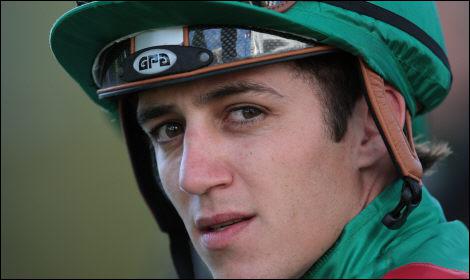 Christophe Soumillon was born in Belgium into horse racing roots. His father rode in steeplechase races and when his son was old enough to seek a career, those horse racing roots led him to an apprenticeship at Chantilly Racecourse in France. The younger Soumillon won his first race at the age of sixteen, winning on a 75-1 longshot named Bruno. He was named the French champion apprentice in 1999, and his career is primarily based in Europe to this day. Christophe Soumillon was born in Belgium into horse racing roots. His father rode in steeplechase races and when his son was old enough to seek a career, those horse racing roots led him to an apprenticeship at Chantilly Racecourse in France. The younger Soumillon won his first race at the age of sixteen, winning on a 75-1 longshot named Bruno. He was named the French champion apprentice in 1999, and his career is primarily based in Europe to this day.
Soumillon’s success continued to multiply after he was named the champion apprentice. He tied an all-time French record for the most wins in a day in 2000. He was named champion jockey in French in 2003, visiting the winners’ circle 207 times that year. He continued to reach the heights of success in France in 2006 as well, once more winning five races in one day. Several of the races he won that day were Group 1 and Group 2 races. He has also won the Prix de l’Arc de Triomphe twice.
Soumillon has a record of success in top races in Britain, Ireland, Dubai, and Japan. While he does have the largest number of wins in France, his tally of wins has a very cosmopolitan flavor.
In North America, he has continued the trend of winning big races in other countries, most notably in the Breeders’ Cup Turf at Belmont Park in 2005 and at Woodbine in the Canadian International in 2011.
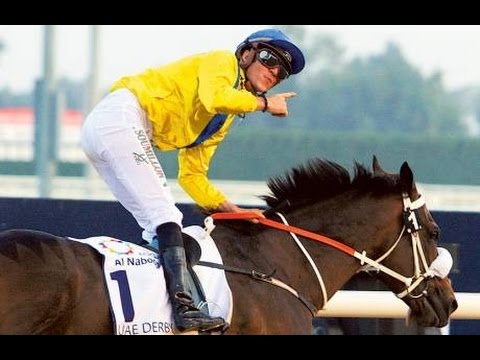 He is also no stranger to repeat feats of success, such as tying the all-time number of daily victories in France twice. In January of this year, Soumillon won two Group 2 races in Dubai on one day. He returned to Dubai in March and captured two more races on Dubai World Cup night. First, he won the Group 2 UAE Derby with Mubtaahij (IRE). Mubtaahij appeared much the best in that race, winning by eight lengths. His trainer will take advantage of the race, which earned his horse 100 points for the Kentucky Derby, and ship him here to try his luck in the 3-year-old classic. It is unclear whether Soumillon will ride Mubtaahij in the Derby or what the horse’s chances will be. If Soumillon does ride him in the Derby, it will be another opportunity to add a top race to an already impressive list of wins at the highest level, tallied across the globe. (Pictured right, Christophe Soumillon aboard Mubtaahij after winning the UAE Derby) He is also no stranger to repeat feats of success, such as tying the all-time number of daily victories in France twice. In January of this year, Soumillon won two Group 2 races in Dubai on one day. He returned to Dubai in March and captured two more races on Dubai World Cup night. First, he won the Group 2 UAE Derby with Mubtaahij (IRE). Mubtaahij appeared much the best in that race, winning by eight lengths. His trainer will take advantage of the race, which earned his horse 100 points for the Kentucky Derby, and ship him here to try his luck in the 3-year-old classic. It is unclear whether Soumillon will ride Mubtaahij in the Derby or what the horse’s chances will be. If Soumillon does ride him in the Derby, it will be another opportunity to add a top race to an already impressive list of wins at the highest level, tallied across the globe. (Pictured right, Christophe Soumillon aboard Mubtaahij after winning the UAE Derby)
In fact (quick side note here), it was photos of Soumillon celebrating the victory after he and Mubtaahij won the UAE Derby that intrigued me enough to make me want to research his life and write about his career. I had heard his name in passing a time or two, it seems, but since he doesn’t race that often in the U.S. most of what he had accomplished was unfamiliar to me. His story of success year after year, though, definitely places him in the rank of top jockeys.
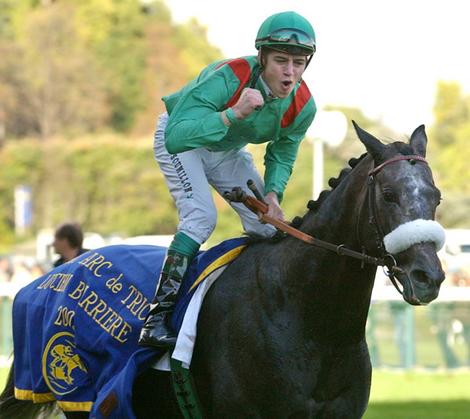 It is interesting that the celebration after the victory in the UAE Derby caught my eye, as it clearly did for photographers at Meydan Racecourse that night. Soumillon himself spoke of his tendency to very demonstrably celebrate wins in an interview with the British newspaper, The Guardian, in 2003. His celebrations have led to him being called a “showman” from time to time, but he described them like this: “Sometimes I just want to enjoy, it’s just a feeling. Sometimes you come back and you see your family or your friends or something that touches you. It gives you power and it’s incredible.” (Pictured left, Christophe Soumillon celebrating aboard Dalakhani after winning the 2003 Prix de l'Arc de Triomphe) It is interesting that the celebration after the victory in the UAE Derby caught my eye, as it clearly did for photographers at Meydan Racecourse that night. Soumillon himself spoke of his tendency to very demonstrably celebrate wins in an interview with the British newspaper, The Guardian, in 2003. His celebrations have led to him being called a “showman” from time to time, but he described them like this: “Sometimes I just want to enjoy, it’s just a feeling. Sometimes you come back and you see your family or your friends or something that touches you. It gives you power and it’s incredible.” (Pictured left, Christophe Soumillon celebrating aboard Dalakhani after winning the 2003 Prix de l'Arc de Triomphe)
Soumillon has had multiple opportunities to feel that incredible power, being a constant visitor to the winners’ circle. He had one more notable trip to make to the winners’ circle on Dubai World Cup night, capturing the Group 1 Dubai Sheema Classic. He told The Guardian’s Greg Wood in 2013 that it is the love of what he does that keeps him going, for as long as he possibly can. That love of what he does was fully evident when Mubtaahij crossed the wire, clearly the best of his rivals in Dubai a few weeks ago. There are few sure things in horse racing, but it seems one that can be counted on is Soumillon having plenty of chances to show that love of his career again and again.

Jockey World Member Sarah Troxell has been a racing enthusiast since she was a child, fueled by her mom's stories of Secretariat and Marguerite Henry and Walter Farley's books about horse racing. The sport fascinates Sarah for its compelling stories and all the twists and turns it can take. She is currently enrolled in the University of Kentucky's Equine Management program. Sarah spent a week last summer writing for the Saratoga Special, and is pursuing a career in racing journalism.
|
|
|
|
|
|
|
|
|
|
|
"Rosie Napravnik"
March 13, 2015 by Sarah Troxell
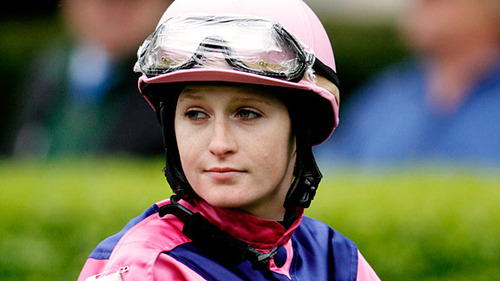 Rosie Napravnik was born in 1988 in New Jersey, and known as Anna Rose Napravnik until she began riding professionally. Her family was not involved with racing, but they definitely gave Napravnik the opportunity to be around horses. Her father is a farrier, and her mother ran a training stable for event horses. Rosie Napravnik was born in 1988 in New Jersey, and known as Anna Rose Napravnik until she began riding professionally. Her family was not involved with racing, but they definitely gave Napravnik the opportunity to be around horses. Her father is a farrier, and her mother ran a training stable for event horses.
It wasn’t until seeing a horse racing documentary when she was seven that Napravnik knew she had found her calling. She said she watched the documentary so much she had it memorized. Racing had taken deep root in the imagination and passion of Napravnik, just as it has for so many people from a young age. Yet what Rosie ended up achieving with that passion is extraordinary. It seems fitting that she watched the documentary so often she memorized it, for that same level of focus and dedication appeared quite evident throughout her riding career. From a fan’s perspective, watching her head out to the track, she seemed very composed and in a zone of almost tranquility, before the competitive fire took over during the race.
Rosie began her path to becoming a jockey by working in trainers’ barns as a young teenager. After a few years under the tutelage of trainer Richard Small, Napravnik got her jockey’s license in 2005 and her first mount was one of Small’s horses. She first had her name printed in programs as A.R. Napravnik, to be considered on her merits as a jockey first, and the fact that she is female second. As it turned out, she has become one of the top jockeys of either gender, and her skill and work ethic made it unnecessary to go by A.R. Napravnik in programs. She is now easily recognized just as she wished, as a jockey first, not solely a female jockey. While she is one of the top female jockeys ever, she has become established enough as a top talent in her field to realize that when she would get a leg up on a mount, she would be seen merely a major contender, gender aside. As a result, her name began to be printed in programs as Rosie Napravnik.
But that was all after she achieved some major pinnacles in racing. She reached her first milestone on June 9, 2005, when she won her first race at Pimlico aboard Ringofdiamonds. In fact, not only was that her first win, it was also the first race she ever rode in as a licensed jockey. It was a very auspicious beginning.
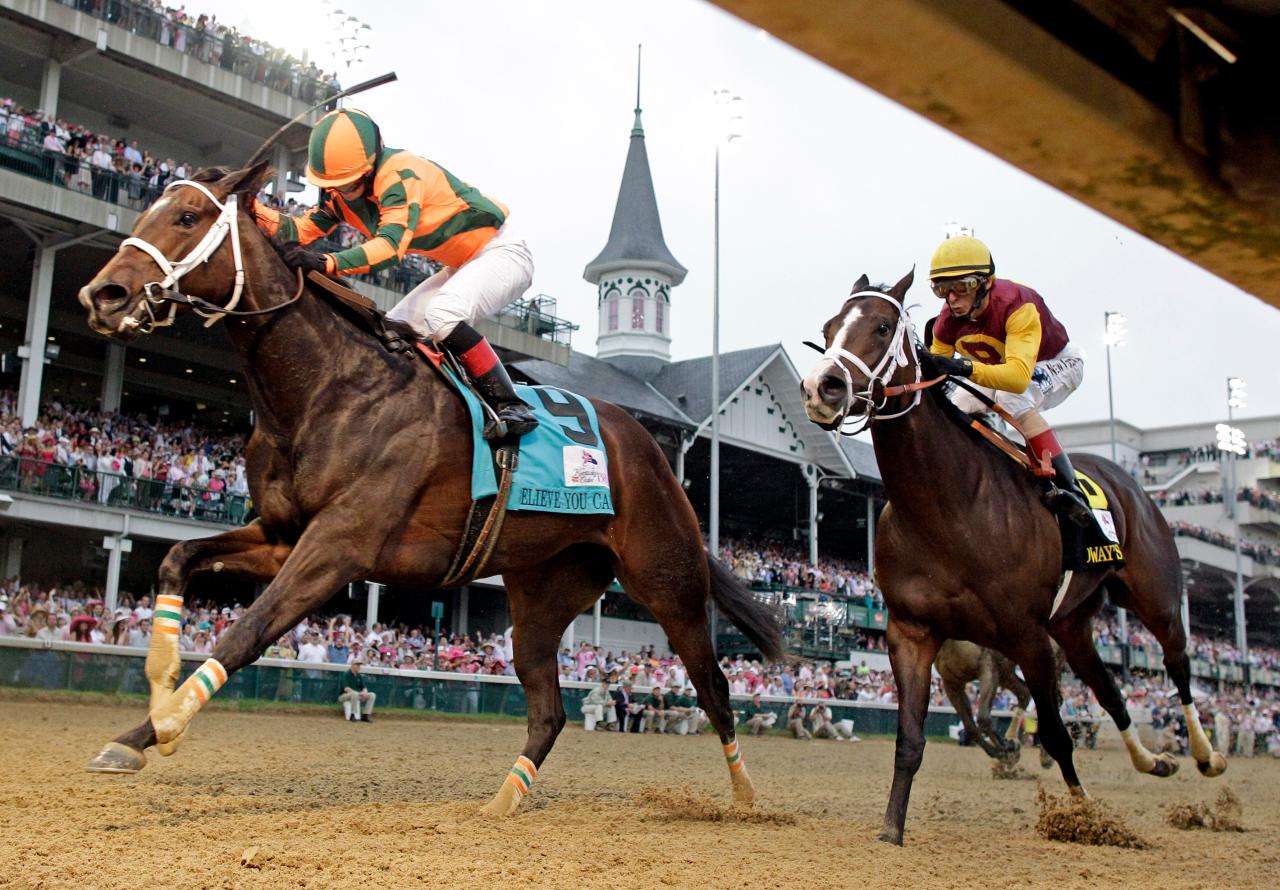 While her list of accomplishments is noteworthy for anyone in the jockey ranks, male or female, she did also achieve some firsts among female jockeys. She was the first female jockey to earn over $10 million in one season in North America, which she did in 2012, and she was also the first female jockey to be Keeneland’s leading rider, winning 17 races during their fall 2013 meet. In 2012 she was in eighth place among all North American riders in season earnings. She was the first female rider to win the Kentucky Oaks, aboard the incredibly aptly-named Believe You Can. Napravnik has undoubtedly inspired many racing enthusiasts, and very likely there are young girls who watched her meteoric rise in this industry and saw what they might be able to do one day, just as Napravnik knew from the racing documentary she watched. Napravnik believes that one reason female jockeys have had a hard time making a mark in racing at the highest levels is because of how tough the sport is. She has said it’s not enough to just be a young girl that loves horses, and follow that love of horses as a woman working on the track. It is also necessary to be tough, strong, and deliver results that stem from an excellent work ethic and professionalism. Napravnik delivers those qualities in spades. (Pictured right, Rosie Napravnik aboard "Believe You Can" enroute to winning the 2012 Kentucky Oaks) While her list of accomplishments is noteworthy for anyone in the jockey ranks, male or female, she did also achieve some firsts among female jockeys. She was the first female jockey to earn over $10 million in one season in North America, which she did in 2012, and she was also the first female jockey to be Keeneland’s leading rider, winning 17 races during their fall 2013 meet. In 2012 she was in eighth place among all North American riders in season earnings. She was the first female rider to win the Kentucky Oaks, aboard the incredibly aptly-named Believe You Can. Napravnik has undoubtedly inspired many racing enthusiasts, and very likely there are young girls who watched her meteoric rise in this industry and saw what they might be able to do one day, just as Napravnik knew from the racing documentary she watched. Napravnik believes that one reason female jockeys have had a hard time making a mark in racing at the highest levels is because of how tough the sport is. She has said it’s not enough to just be a young girl that loves horses, and follow that love of horses as a woman working on the track. It is also necessary to be tough, strong, and deliver results that stem from an excellent work ethic and professionalism. Napravnik delivers those qualities in spades. (Pictured right, Rosie Napravnik aboard "Believe You Can" enroute to winning the 2012 Kentucky Oaks)
Napravnik has been a leading rider at multiple tracks spanning from 2010 to 2014. Some of her other noteworthy achievements were winning the 2012 Breeders’ Cup Juvenile with Shanghai Bobby, and the 2014 Breeders’ Cup Distaff on Untapable, who was named a champion 3-year-old filly for her feats that season, which included beating older horses in the Distaff.
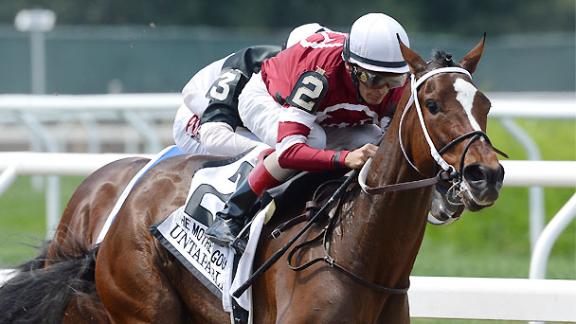 When Napravnik rode Untapable in the 2014 Distaff, she had just come out of another stellar meet at Keeneland, where she was again named their leading rider. When Untapable left the winners’ circle after her Breeders’ Cup Distaff triumph, Napravnik had a surprising announcement to make when asked what the filly Untapable and the Breeders’ Cup win meant to her. She said, “As far as how much it means to me, I can’t really explain, but I’m going to have to explain it to my mom first. I wanted to tell you in person [turning to her mom, who was in the winners’ circle] that my retirement starts Sunday [the day after the announcement].” Her mother was understandably incredibly surprised and so was most of the racing world. But what a way to wrap up a career, winning such a prestigious race and fresh off of another meet title as a leading rider at one of the country’s top tracks. Napravnik went on to say, “Joe and I are starting a family.” It was a completely impromptu moment, but one that Napravnik felt was a perfect opportunity to make her announcement. She said Untapable is such a special filly that winning a race aboard her seemed like a special way to wrap up her career. (Pictured right, Napravnik aboard "Untapable" as they cruise home in the 2014 Mother Goose Stakes) When Napravnik rode Untapable in the 2014 Distaff, she had just come out of another stellar meet at Keeneland, where she was again named their leading rider. When Untapable left the winners’ circle after her Breeders’ Cup Distaff triumph, Napravnik had a surprising announcement to make when asked what the filly Untapable and the Breeders’ Cup win meant to her. She said, “As far as how much it means to me, I can’t really explain, but I’m going to have to explain it to my mom first. I wanted to tell you in person [turning to her mom, who was in the winners’ circle] that my retirement starts Sunday [the day after the announcement].” Her mother was understandably incredibly surprised and so was most of the racing world. But what a way to wrap up a career, winning such a prestigious race and fresh off of another meet title as a leading rider at one of the country’s top tracks. Napravnik went on to say, “Joe and I are starting a family.” It was a completely impromptu moment, but one that Napravnik felt was a perfect opportunity to make her announcement. She said Untapable is such a special filly that winning a race aboard her seemed like a special way to wrap up her career. (Pictured right, Napravnik aboard "Untapable" as they cruise home in the 2014 Mother Goose Stakes)
When Napravnik made her announcement that day, she and husband Joe Sharp had been expectant parents for seven weeks, and she knew retirement was in the works. It is astounding to think of all she has achieved in such a short span of time racing professionally, and even a little stunning to think she won’t still have her name printed in programs as a jockey at so many of the tracks where she made a huge mark.
For now, she has turned to helping her husband with his recently-launched stable of racehorses, performing assistant trainer duties. Sharp had served as an assistant trainer in the barns of Mike Maker and Mike Stidham before turning to training on his own in 2014. Even in riding retirement, horses are still a major way of life for Napravnik. The difference is, she gets to focus more on the daily care of the horses and her horsemanship, instead of just brief interactions with them that riding during races provided. For her, that is a definite plus.
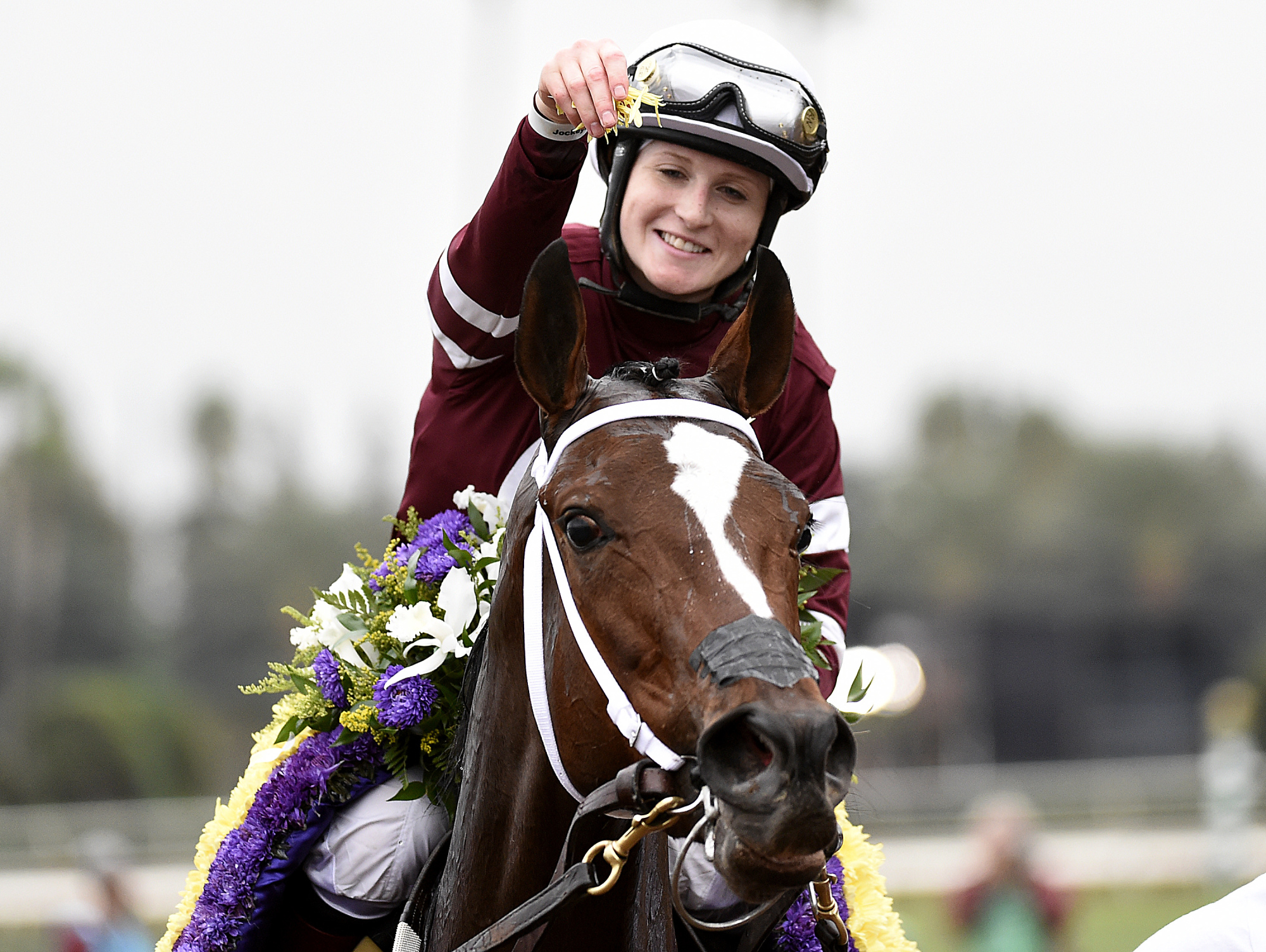 As for riding, she hasn’t ruled out returning. She is definitely still young enough to take off a few years to give all her focus to her family, and then come back to riding if the time is right. She has said at this time she doesn’t miss being a jockey that much, and acknowledged there will be time to reassess if she wants to return or not further down the road. As for riding, she hasn’t ruled out returning. She is definitely still young enough to take off a few years to give all her focus to her family, and then come back to riding if the time is right. She has said at this time she doesn’t miss being a jockey that much, and acknowledged there will be time to reassess if she wants to return or not further down the road.
For now, Napravnik’s life is devoted to her husband’s stable, which is doing very well, and the expected arrival of their son on June 9th, which is fittingly ten years to the day after she rode her first winner. Everything she did and achieved as a jockey was incredible, but with motherhood on the horizon, the day she welcomes her son will probably be as great a feeling as any of the numerous times she crossed the finish line in front. And in the future, if Napravnik does come back to riding, it will be great to see her name in the programs and that cool, calm focus as all of her hard work and skill help power her and her mounts to the winner’s circle once more.

Jockey World Member Sarah Troxell has been a racing enthusiast since she was a child, fueled by her mom's stories of Secretariat and Marguerite Henry and Walter Farley's books about horse racing. The sport fascinates Sarah for its compelling stories and all the twists and turns it can take. She is currently enrolled in the University of Kentucky's Equine Management program. Sarah spent a week last summer writing for the Saratoga Special, and is pursuing a career in racing journalism.
|
|
|
|
|
|
|
|
|
|
|
"Johnny Longden"
February 20, 2015 by Sarah Troxell
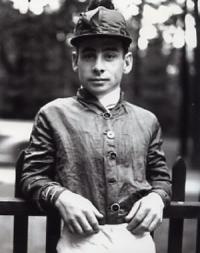 Johnny Longden was born in England in 1907, and raised in Canada, but he found most of his fame for his prowess in the saddle in the U.S. He actually did not decide to become a jockey until the age of twenty, and there is little to suggest he had much horse experience before that. It didn't matter, though. He quickly established himself as a major force in the racing world. While he primarily rode in California, two of his most notable career achievements – one as a jockey, and one in his post-saddle days – came in the United States' most famous Derby. It is interesting to note that it was patterned upon the Epsom Derby in England, and a Britain-born horseman guided two well-known horses to triumphs on the first Saturday in May in this country's own version of one of his birth country's most notable races. Johnny Longden was born in England in 1907, and raised in Canada, but he found most of his fame for his prowess in the saddle in the U.S. He actually did not decide to become a jockey until the age of twenty, and there is little to suggest he had much horse experience before that. It didn't matter, though. He quickly established himself as a major force in the racing world. While he primarily rode in California, two of his most notable career achievements – one as a jockey, and one in his post-saddle days – came in the United States' most famous Derby. It is interesting to note that it was patterned upon the Epsom Derby in England, and a Britain-born horseman guided two well-known horses to triumphs on the first Saturday in May in this country's own version of one of his birth country's most notable races.
The first of these Kentucky Derby winners was Count Fleet. Count Fleet must have been an incredible horse. Not only was he a Triple Crown winner, a feat well-known for being difficult to achieve, but he also won the Belmont Stakes of 1943 by an unprecedented 25 lengths. There was no doubt he was a superior racehorse, and much the best of that race, and probably of the foal crop of 1940 as well. That accomplishment must have seemed astounding to bystanders, to see a horse romp home in such a prestigious race designed to attract the top 3-year-olds, and his winning margin stood as the largest one in Belmont Stakes history until another incredible “tremendous machine” eclipsed it in 1970. That of course, was when Secretariat turned in his own Belmont tour-de-force, to cap a Triple Crown victory just as emphatically as Count Fleet had done three decades prior. (Pictured below: Johnny Longden aboard Count Fleet)
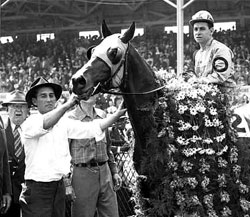 Longden rode during the same time as Eddie Arcaro, who was also a fellow Triple Crown winner. It was with Arcaro and fellow jockey, Sammy Renick that Longden helped found the Jockeys' Guild, creating a lasting influence on the sport that lingers to this day. Longden rode during the same time as Eddie Arcaro, who was also a fellow Triple Crown winner. It was with Arcaro and fellow jockey, Sammy Renick that Longden helped found the Jockeys' Guild, creating a lasting influence on the sport that lingers to this day.
Longden won his first race in 1927, and from there he saw his career rise and rise, eventually riding over 6,000 winners in a career of nearly forty years. That record of wins compiled by one jockey stood until Bill Shoemaker broke it in 1970. As Shoemaker himself was a top-notch jockey, there was no shame in being second to him. There are not many jockeys who have come close to winning 6,000 races, in fact, Longden remained in the top tier of jockeys by number of career wins even after Shoemaker surpassed that record.
Longden rode his final race at the age of 59, steering George Royal with dead aim for the wire, winning by a nose after a back-and-forth duel down the stretch in the San Juan Capistrano Handicap. It was a thrilling conclusion to an incredible career. Not only had his career found him to be at the top of the standings in terms of number of races won and made him a Triple Crown winner to boot, it also saw him elected to the Hall of Fame in 1958.
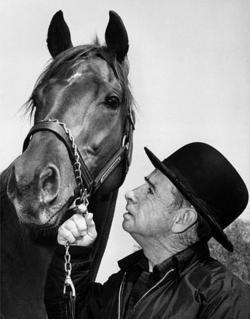 But Longden had more to impart to racing when he hung up his tack and left the ranks of professional jockeys. He turned to training in 1966, fresh off the track, and that too was a highly successful career for him. It was a career that had one more “big name” defining horse come across his path. In Longden's hands, Majestic Prince became a Kentucky Derby winner in 1969. That gave Longden the unique distinction of being the sole racing professional to ride and to saddle a Derby winner. In fact, he came very close to capturing a Triple Crown. But Majestic Prince didn't have Count Fleet's dominating style in the Belmont, proving once more how difficult it is even for a standout horse to win the series. That aside, Longden's training prowess was still shown to full advantage with Majestic Prince's Derby and Preakness wins. But Longden had more to impart to racing when he hung up his tack and left the ranks of professional jockeys. He turned to training in 1966, fresh off the track, and that too was a highly successful career for him. It was a career that had one more “big name” defining horse come across his path. In Longden's hands, Majestic Prince became a Kentucky Derby winner in 1969. That gave Longden the unique distinction of being the sole racing professional to ride and to saddle a Derby winner. In fact, he came very close to capturing a Triple Crown. But Majestic Prince didn't have Count Fleet's dominating style in the Belmont, proving once more how difficult it is even for a standout horse to win the series. That aside, Longden's training prowess was still shown to full advantage with Majestic Prince's Derby and Preakness wins.
Longden was also awarded the George Woolf Memorial Jockey Award in 1952, for jockeys that reflect upon racing in an exemplary manner, and was given the Avelino Gomez Memorial Award in 1985 - which is similar to the George Woolf Memorial Award - to recognize Canadian-raised or born racing participants. Longden also was elected to the Canadian Horse Racing Hall of Fame and Canada's Sports Hall of Fame.
Longden passed away in 2003, ironically, on the same date he was born, February 14th, at age 86. Understandably, he had the fondest memories of Count Fleet, even after riding so many winners and a slew of great horses over the span of his career. I once heard Count Fleet described as blazing a comet across the racing horizon in 1943 and that description has stayed with me. It is easy to believe a horse like that would linger in someone's memory for decades, just as Longden's name is still ranked as one of the greatest in horse racing. He left an incredible legacy, both as a jockey and as a trainer.

Jockey World Member Sarah Troxell has been a racing enthusiast since she was a child, fueled by her mom's stories of Secretariat and Marguerite Henry and Walter Farley's books about horse racing. The sport fascinates Sarah for its compelling stories and all the twists and turns it can take. She is currently enrolled in the University of Kentucky's Equine Management program. Sarah spent a week last summer writing for the Saratoga Special, and is pursuing a career in racing journalism.
|
|
|
|
|
|
|
|
|
|
|
"Eddie Arcaro"
January 15, 2015 by Sarah Troxell
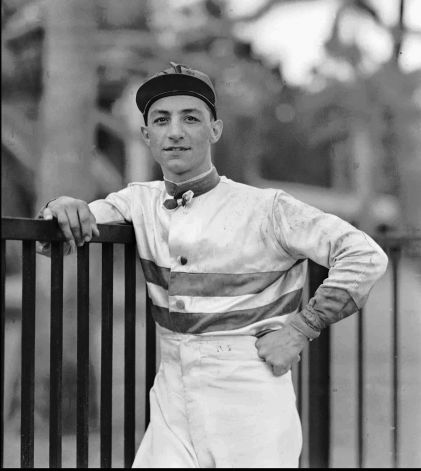 When Eddie Arcaro was born in the early 1900's in Ohio, there was nothing in his immediate family background to suggest he would become one of the most well-known jockeys ever, or that he would become a jockey at all, for that matter. There was one thing about his childhood that somewhat helped him on that road, however. According to his autobiography, he had to stick to a special diet due to issues digesting certain foods and this could very well have contributed to him staying small even as other kids of his age reached a more typical size. When Eddie Arcaro was born in the early 1900's in Ohio, there was nothing in his immediate family background to suggest he would become one of the most well-known jockeys ever, or that he would become a jockey at all, for that matter. There was one thing about his childhood that somewhat helped him on that road, however. According to his autobiography, he had to stick to a special diet due to issues digesting certain foods and this could very well have contributed to him staying small even as other kids of his age reached a more typical size.
Another occurrence of his childhood that steered him towards the races was when he suffered a severe leg injury that kept him bedridden and out of school for months. He began work as a golf caddy rather than going back to school once he was healed, feeling he had missed too much time. It was there on a local golf course that he began to mingle with racing people. They fascinated him, and when one of them even told him he'd never be a caddy but should try being a jockey, that idea took root. He was only thirteen at the time, but he couldn't deny the fascination the track already held for him and he began reading everything he could about racing, the horses, and the jockeys making all the headlines at the time. That thirst for racing knowledge and to follow the sport through the years and seasons has no doubt turned many young people into racing professionals, and it was no different for Eddie Arcaro.
He began work at Latonia Racecourse not long after that, taking care of horses and riding a little around the shed row. It took him a few years to begin riding races, and he notched his first victory when he was nearly sixteen, but it wasn't until the fall of that same year that he began racking up strings of wins, and put together several leading rider titles back-to-back. He was on his way.
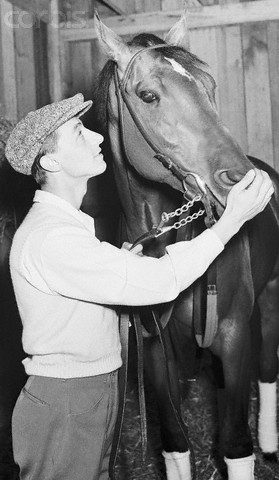 But just when it seemed he was on the way up, greatly increasing his number of winners from the previous year, he was told he would not be allowed to ride at Washington Park near Chicago because his rough riding endangered himself and others. He was stunned by that, but it turned out to actually be a lucky break. One day a man saw him on the backstretch and handed him a card, telling him to drop by his office. Arcaro didn't know the man, but he must have recognized him and the card said that he was Roy Carruthers, the track's general manager. But just when it seemed he was on the way up, greatly increasing his number of winners from the previous year, he was told he would not be allowed to ride at Washington Park near Chicago because his rough riding endangered himself and others. He was stunned by that, but it turned out to actually be a lucky break. One day a man saw him on the backstretch and handed him a card, telling him to drop by his office. Arcaro didn't know the man, but he must have recognized him and the card said that he was Roy Carruthers, the track's general manager.
As it turned out, Carruthers ran horses in his wife's name and had a connection with Warren Wright, the owner of Calumet Farm. When Arcaro met with the man in his office, he left with his riding career reinstated and with first call from the Carruthers stable. Not long after that, Warren Wright bought out Arcaro's contract, and he began riding for Calumet in 1934. He and the Calumet horses found an affinity right away, and he rode top filly Nellie Flag to his biggest payday yet in winning the Selima Stakes. He was on his way up again, a top jockey contracted to a top stable, and given every chance to continue to show all the promise he had exhibited in his ascent up the jockey ranks in 1932 and 1933.
It was for Calumet that he won his first Kentucky Derby in 1938, aboard Lawrin. It made up a little for Nellie Flag finishing fourth as his first Derby mount, an effort that only whetted his appetite to be back at Churchill Downs in their biggest race on their biggest day, and this time be the jockey atop the winner when the blanket of roses was placed over his withers. The accolades poured in, from Churchill Downs' announcer calling “Arcaro's ride on Lawrin...a masterpiece from start to finish,” to the Cincinnati Post journalist, Ben Dahlman, summing up Arcaro's skills by writing, “Horsemen rate him the peer of all riders, and after watching him bring Lawrin home through a tangled field in the Kentucky Derby, Eddie is certainly entitled to that title.” Another journalist even said Arcaro had earned his place in the Hall of Fame for his Derby ride, only a few short years into his career. That promise held true.
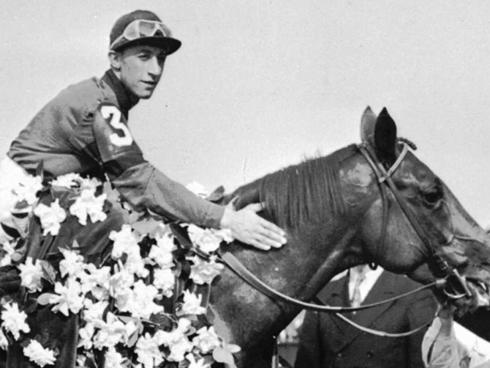 It was just a few years later, in 1941, that Arcaro reached a peak few in racing ever have, when he won the Triple Crown aboard Whirlaway. Ironically, when he first saw him, Arcaro initially did not want to ride Whirlaway, believing the horse to be crazy and a bit of a rogue. While Whirlaway is famously a Calumet horse, Arcaro was also riding for Greentree Stable at that time and was hoping to ride for them in the Kentucky Derby that year instead. So he asked Whirlaway's trainer Ben Jones to wait until he heard Greentree's plans for the Derby before he committed to riding Whirlaway, as Jones hoped he would do. It was just a few years later, in 1941, that Arcaro reached a peak few in racing ever have, when he won the Triple Crown aboard Whirlaway. Ironically, when he first saw him, Arcaro initially did not want to ride Whirlaway, believing the horse to be crazy and a bit of a rogue. While Whirlaway is famously a Calumet horse, Arcaro was also riding for Greentree Stable at that time and was hoping to ride for them in the Kentucky Derby that year instead. So he asked Whirlaway's trainer Ben Jones to wait until he heard Greentree's plans for the Derby before he committed to riding Whirlaway, as Jones hoped he would do.
When Arcaro and Whirlaway won the Derby by 8 ½ lengths that day in May 1941, the ride was again hailed as a display of the jockey's ability to win a race that others may have lost, especially aboard a horse prone to bearing out and losing ground as Whirlaway had been. Arcaro kept him on a straight course by running between foes, and having nowhere to veer, it paid off impressively. From there, he and Whirlaway won the Preakness, also by daylight, and it was on to New York for a shot at the Triple Crown. It was there, according to his autobiography, that Arcaro found a real rapport with Whirlaway, the horse he once thought too crazy to even ride. As Jones had said, Whirlaway just needed the right rider, and that was Arcaro.
In the Belmont, a field of four lined up in the starting gate, and the other three entrants were no match for Whirlaway. He was given a challenge near the end of the race but still won by over two lengths, giving Arcaro and himself a rare place in the annals of racing by becoming Triple Crown winners. The victories also gave Arcaro his first Preakness and Belmont wins. (Pictured above, left Arcaro aboard Whirlaway after winning the 1941 Belmont Stakes)
In addition to his own skill as a rider, his association with Calumet was another reason for Arcaro's resounding success. This business partnership was especially fruitful once again when Citation made it to the races. Unlike with Whirlaway, Arcaro sought out the opportunity to ride Citation. He saw greatness in him, and Citation did not disappoint. Winning the Triple Crown aboard him was nearly effortless, and gave Arcaro the rare distinction of winning two Triple Crowns. He remains the only jockey to date to achieve that feat, but he and Citation had more to do and they kept racking up victories throughout 1948, rolling through other top races, including a walkover in the Pimlico Special. Citation was just too good for the other top horses running then, and Arcaro considered him one of the best he'd ever ridden.
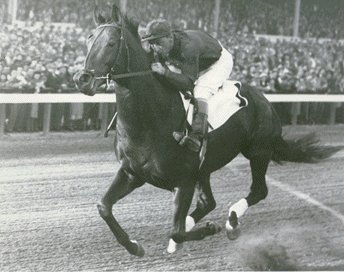 His Kentucky Derby victory aboard Citation was one of five Arcaro would claim during the course of his career. He rose to pinnacles he probably never would have guessed he would achieve when he was a young boy being raised in a non-racing family who absorbed as much about racing as he possibly could from the sidelines, but no doubt that passion and the mentors he had fueled his success. His Kentucky Derby victory aboard Citation was one of five Arcaro would claim during the course of his career. He rose to pinnacles he probably never would have guessed he would achieve when he was a young boy being raised in a non-racing family who absorbed as much about racing as he possibly could from the sidelines, but no doubt that passion and the mentors he had fueled his success.
In 1958, he was voted into the Racing Hall of Fame, just as one sportswriter had claimed he would be after his first Derby win aboard Lawrin, and as countless people had probably surmised would happen after watching him ride some of the best horses of his era and win top races year after year. (Pictured right, Eddie Arcaro aboard Citation)
When he retired from racing in 1962, Arcaro had won over 4,700 races and been the sport's highest-paid jockey for several years. He still stayed involved in racing, as an analyst, and invested in several businesses with his racetrack earnings. He also had helped found the Jockeys' Guild while still an active jockey. Arcaro's name still looms large in the racing world today, for he was a master of his craft, even as he had several brushes with suspensions for rough riding. If he had only won the Triple Crown once instead of twice, that alone would have been enough to keep his name in the record books.
But Arcaro never rested on his laurels and he continued to excel across the country and aboard many different horses, year after year. What he achieved endures, as do the names of the horses he rode so well. He is every bit a legend, as much as Citation and Whirlaway themselves became.

Jockey World Member Sarah Troxell has been a racing enthusiast since she was a child, fueled by her mom's stories of Secretariat and Marguerite Henry and Walter Farley's books about horse racing. The sport fascinates Sarah for its compelling stories and all the twists and turns it can take. She is currently enrolled in the University of Kentucky's Equine Management program. Sarah spent a week last summer writing for the Saratoga Special, and is pursuing a career in racing journalism.
|
|
|
|
|
|
|
|
|
|
|
"Ramon Dominguez"
December 19, 2014 by Sarah Troxell
 Horse of the Year Havre de Grace. Breeders’ Cup Juvenile winner Hansen. Multiple Eclipse Award winner. Six winners in one day on a Saratoga card in 2012. Winner of the George Woolf Memorial Award in 2012, indicating the immense respect his peers hold for him. Any one of these mounts, achievements, or accolades could have been career pinnacles for a jockey. For Ramon Dominguez, though he always lets his accomplishments speak for themselves, they were just a natural effect of his skill in the saddle and his upstanding reputation on and off the track. Horse of the Year Havre de Grace. Breeders’ Cup Juvenile winner Hansen. Multiple Eclipse Award winner. Six winners in one day on a Saratoga card in 2012. Winner of the George Woolf Memorial Award in 2012, indicating the immense respect his peers hold for him. Any one of these mounts, achievements, or accolades could have been career pinnacles for a jockey. For Ramon Dominguez, though he always lets his accomplishments speak for themselves, they were just a natural effect of his skill in the saddle and his upstanding reputation on and off the track.
Dominguez was born in Venezuela in 1976 and began his riding career there. He described himself as self-taught, and was born into a family with only slight racing ties that were not enthused about his desire to become a jockey. This changed after his parents let him take show-jumping lessons and he ran into someone on the way to the lessons who was working at a training center. Dominguez also began working at the training center and progressed to riding at bush tracks and the racecourse La Rinconada until he moved to the U.S. in 1996.
He rose to the top of the win standings in just a few short years after his arrival in the U.S. New York and surrounding states are where he achieved some of his greatest successes. Dominguez won nine riding titles in New York in less than two years, and he was also a regular rider for trainer Graham Motion. It was this connection to Motion that gave Dominguez his first Breeders’ Cup win in 2004 when he captured the Breeders’ Cup Turf aboard Better Talk Now.
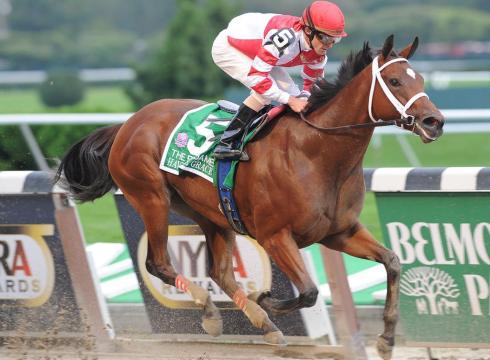 Dominguez was described as having a gift, a patient way with horses, and that worked with Better Talk Now. He was reportedly not an easy horse to handle or work with. Dominguez was described as having a gift, a patient way with horses, and that worked with Better Talk Now. He was reportedly not an easy horse to handle or work with.
Anyone who ever watched Dominguez ride saw that innate gift shine through, and watched as the horses responded to it. It takes many different qualities to be a top rider and win multiple riding titles, but having a gift like his goes a long way toward making it happen. (Dominguez pictured right aboard Havre de Grace)
I was in attendance the day he won the record-tying six races on a single Saratoga card in 2012, and what stood out most besides his skill in achieving that feat was the time he made for the fans who wanted to congratulate him and get photos with him after the sixth win. He accommodated as many as possible before he had to go back to the jockeys’ quarters, with a graciousness that has made him one of racing’s ambassadors.
That is one of the great legacies Dominguez has left the sport. It is unfortunate, in a sense, to talk of his legacy when one would have hoped to see him ride for quite a few more years and help even more horses, like Better Talk Now, benefit from his patient handling and show the world what they were capable of.
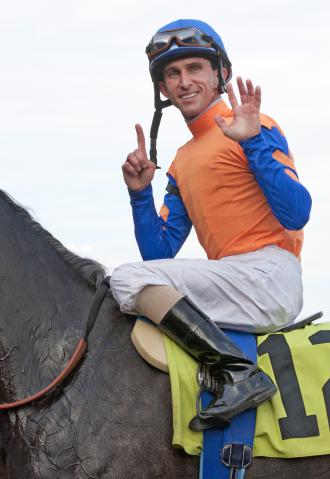 Perhaps sometimes one of the toughest things can be the question of when to hang up one’s tack and retire from a career that is more a calling than merely a living. Dominguez did not get to choose when he retired, after sustaining a serious spill in 2013, one that ultimately led his doctors to advise against him returning to racing. It was by no means the end of his mark on racing, however. He continued to receive accolades and honors after his retirement, including several days held in his honor at tracks where he had a big impact, from New York to Maryland to Delaware. Perhaps sometimes one of the toughest things can be the question of when to hang up one’s tack and retire from a career that is more a calling than merely a living. Dominguez did not get to choose when he retired, after sustaining a serious spill in 2013, one that ultimately led his doctors to advise against him returning to racing. It was by no means the end of his mark on racing, however. He continued to receive accolades and honors after his retirement, including several days held in his honor at tracks where he had a big impact, from New York to Maryland to Delaware.
I also happened to be at Saratoga in 2013 when he made an appearance as part of the outreach of the Permanently Disabled Jockeys’ Fund. Even though it was recommended he no longer ride, Dominguez was still there on behalf of other jockeys who needed more assistance. It is this part of his nature that resonated with so many people who encountered him during his racing career, whether they were fans or worked with him directly, from day to day. Wherever Dominguez goes from here, if he one day finds another niche at the track, it was great to see him that day back at the scene of so many of his greatest triumphs. It was probably also a little bittersweet for everyone who knew him, but what he did during his riding years is etched into the sport’s annals of fame. He also was the recipient of the Mike Venezia Award in 2013, given to jockeys who display extraordinary citizenship and sportsmanship. It’s only a matter of time until he finds himself in the Hall of Fame. After all, it is all that Dominguez achieved that will linger in people’s minds. He took the racing world by storm, though perhaps a quieter storm that flowed from his humble nature and made all his achievements seem nearly effortless, and at times, unmatchable.

Jockey World Member Sarah Troxell has been a racing enthusiast since she was a child, fueled by her mom's stories of Secretariat and Marguerite Henry and Walter Farley's books about horse racing. The sport fascinates Sarah for its compelling stories and all the twists and turns it can take. She is currently enrolled in the University of Kentucky's Equine Management program. Sarah spent a week last summer writing for the Saratoga Special, and is pursuing a career in racing journalism.
|
|
|
|
|
|
|
|
|
|
|
"Florent Geroux"
November 15, 2014 by Sarah Troxell
 When Florent Geroux was growing up, his father worked as a jockey and then began training horses. This put the younger Geroux in the midst of the racing world from the beginning, and he eventually enrolled in the riding academy Afasec at the age of thirteen. When he began riding professionally, he went on to become a leading apprentice in France. When Florent Geroux was growing up, his father worked as a jockey and then began training horses. This put the younger Geroux in the midst of the racing world from the beginning, and he eventually enrolled in the riding academy Afasec at the age of thirteen. When he began riding professionally, he went on to become a leading apprentice in France.
Geroux first rode at Keeneland in the fall of 2007, after coming to the United States to ride for trainer Patrick Biancone. Geroux had a spill on the opening day of the Keeneland meet that year, requiring several months to recover from a broken wrist. Though he had planned to ride that entire meet, he took off several months to recuperate and came in again strong. His return to riding in the U.S. was centered around the Chicago circuit, and he captured enough wins to be 10th in the jockey standings at Arlington in 2010. He then went on to win the 2011 Illinois Derby and the Hawthorne fall meet riding title that same year.
He remains a top jockey at Arlington, having had mounts on graded-stakes winners I'm Already Sexy and The Pizza Man and rising even higher in the jockey standings. In fact, Geroux won three of the four stakes races on the Arlington card one day in mid-July 2014 aboard those two horses, as well as Divine Oath. As he said in an interview earlier this year, hard work pays off and that definitely is showing its dividends in his career.
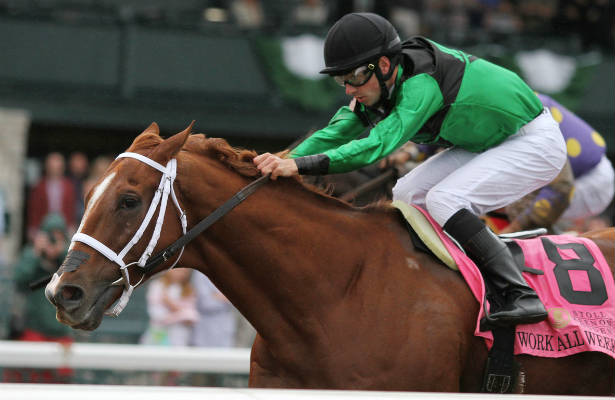 Geroux moved his tack to Keeneland for the 2014 fall meet and when it wrapped up, he was in the top 10 among jockeys by number of wins. He rode that momentum later in the month all the way to the Breeders' Cup at Santa Anita, a cross-country trip that once again showed his hard work pay off as he and Work All Week captured the Breeders' Cup Sprint. That marked Geroux's first Breeders' Cup win, on his first Breeders’ Cup mount. Work All Week is a consistent runner who's only run off the board once, and Geroux rode him well, sitting just behind pace-setter Fast Anna until they entered the turn and holding that clear advantage and smooth trip to prevail against all challengers. Geroux moved his tack to Keeneland for the 2014 fall meet and when it wrapped up, he was in the top 10 among jockeys by number of wins. He rode that momentum later in the month all the way to the Breeders' Cup at Santa Anita, a cross-country trip that once again showed his hard work pay off as he and Work All Week captured the Breeders' Cup Sprint. That marked Geroux's first Breeders' Cup win, on his first Breeders’ Cup mount. Work All Week is a consistent runner who's only run off the board once, and Geroux rode him well, sitting just behind pace-setter Fast Anna until they entered the turn and holding that clear advantage and smooth trip to prevail against all challengers.
It seems fitting, in fact, that his first Breeders' Cup winner is named Work All Week, for how often Geroux credits his hard work for his success. That work ethic, which he and Work All Week have shown throughout both of their careers, was in full display that afternoon in the shadow of the San Gabriel Mountains. One can only imagine Geroux will continue to find Breeders' Cup success, stakes wins, and riding titles as the career he launched early in his life grants him more and more opportunities to shine.

Jockey World Member Sarah Troxell has been a racing enthusiast since she was a child, fueled by her mom's stories of Secretariat and Marguerite Henry and Walter Farley's books about horse racing. The sport fascinates Sarah for its compelling stories and all the twists and turns it can take. She is currently enrolled in the University of Kentucky's Equine Management program. Sarah spent a week last summer writing for the Saratoga Special, and is pursuing a career in racing journalism.
|
|
|
|
|
|
|
|
|
|
|
"Julien Leparoux"
October 15, 2014 by Sarah Troxell
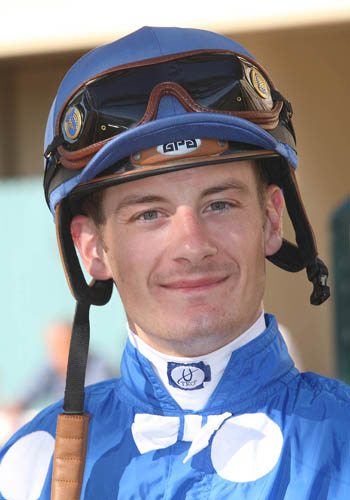 Julien Leparoux was born in Senlis, France, on July 15, 1983. Senlis is not far from Chantilly, the seat of most horse racing activity in France. His father was a jockey who later became a trainer, and it didn’t take long for the younger Leparoux to follow in his father’s footsteps, and it took even less time for him to rise to the top as a jockey. He moved to the United States in 2003, working as an exercise rider for Patrick Biancone. Julien Leparoux was born in Senlis, France, on July 15, 1983. Senlis is not far from Chantilly, the seat of most horse racing activity in France. His father was a jockey who later became a trainer, and it didn’t take long for the younger Leparoux to follow in his father’s footsteps, and it took even less time for him to rise to the top as a jockey. He moved to the United States in 2003, working as an exercise rider for Patrick Biancone.
In 2005, Leparoux began his career as a jockey and he won the Eclipse Award for Outstanding Apprentice Jockey in 2006 after winning 403 races, putting him on the top of the win standings for that year. Those wins included six stakes races at the always ultra-competitive Keeneland meet. The top tracks throughout the country are bound to include Leparoux’s name among the entries, and the title of leading rider is often not far behind. Leparoux has won leading rider titles multiple times at Keeneland, Churchill Downs and Turfway Park.
A natural part of winning so many races and riding titles is the opportunity to get on top horses, and for Leparoux those have come in spades. To name just a few, Leparoux has teamed up with Forever Together, Informed Decision, and Einstein. He captured victories in Breeders’ Cup races with Forever Together and Informed Decision. Leparoux has won five Breeders’ Cup races to date, the most recent coming in 2009 when he captured 3; one of those aboard Informed Decision, and landed the Eclipse Award for Outstanding Jockey. He is only the fourth jockey to be named Outstanding Apprentice Jockey and Outstanding Jockey during his career in the history of the Eclipse Awards.
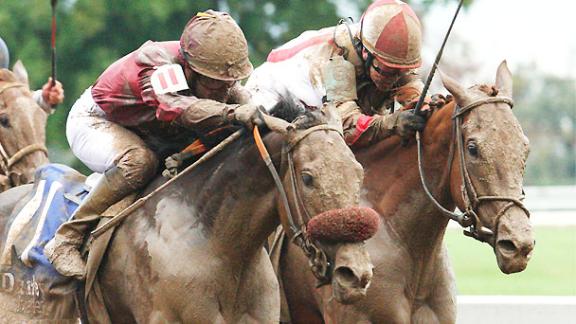 Leparoux was back to his winning ways at Keeneland with this year’s fall meet, winning the G1 Alcibiades on opening day aboard Peace and War. He came into the Keeneland meet having earned yet another riding title, tying with Rosie Napravnik as the leading rider at Kentucky Downs. Leparoux was back to his winning ways at Keeneland with this year’s fall meet, winning the G1 Alcibiades on opening day aboard Peace and War. He came into the Keeneland meet having earned yet another riding title, tying with Rosie Napravnik as the leading rider at Kentucky Downs.
(Shown right: Julien Leparoux on the outside aboard the 11, Peace and War, on their way to victory in the 2014 Darley Alcibiades Stakes.)
Race nine at Churchill Downs on October 29, 2014, had the winner’s trip summed in an Equibase chart as a race well-ridden, saying: “IN MY TIME opened clear to dictate terms, was well handled and safely led throughout.” This race marked the three-year-old filly’s third career victory, but the most significant aspect of it was that when they hit the wire a length ahead of their competitors, it was Julien Leparoux’s 2,000th career victory. That win fulfilled a lot of the promise seen in his career from the earliest days, and also seemed a natural milestone for him to reach one day. Leparoux nearly hit that achievement on one of the last days of the Keeneland fall 2014 meet, reaching wins 1,998 and 1,999 on the next-to- last day of racing there. But it took a few more tries and shifting gears to the Louisville track before he hit the milestone. Leparoux told the Blood Horse in an interview after the victory that this now leaves him free to focus on his six mounts in the 2014 Breeders’ Cup, where he will attempt to add to his tally of three victories in that series so far, continuing his journey to the next big wins that began when he started riding in France, and was sustained in the U.S. from the time he won the Eclipse Award as Outstanding Apprentice Jockey to all his present success.
With racing in his blood and all the success he has achieved at the highest level so early in his career, there is much potential and hopefully many more milestones to come for Julien Leparoux.

Jockey World Member Sarah Troxell has been a racing enthusiast since she was a child, fueled by her mom's stories of Secretariat and Marguerite Henry and Walter Farley's books about horse racing. The sport fascinates Sarah for its compelling stories and all the twists and turns it can take. She is currently enrolled in the University of Kentucky's Equine Management program. Sarah spent a week last summer writing for the Saratoga Special, and is pursuing a career in racing journalism.
|
|
|
|
|
|
|
|
|
|
|
"Laffit Pincay, Jr."
September 13, 2014 by Sarah Troxell
 Laffit Pincay, Jr. was born in Panama City, Panama, and grew up watching his jockey father ride. Like many other jockeys, this no doubt played a role in his decision to follow in that profession, and he began riding in Panama before moving to the U.S. in the mid-1960s to ride for Fred W. Hooper. Hooper was a horseman who had a major impact on Thoroughbred racing through the horses he campaigned and for being a pioneer in the sport, founding the Thoroughbred Owners and Breeders Association and also bringing Latin American jockeys to the U.S. It is fitting that his story intersects with Pincay Jr’s, for they both had lasting impacts on racing. Laffit Pincay, Jr. was born in Panama City, Panama, and grew up watching his jockey father ride. Like many other jockeys, this no doubt played a role in his decision to follow in that profession, and he began riding in Panama before moving to the U.S. in the mid-1960s to ride for Fred W. Hooper. Hooper was a horseman who had a major impact on Thoroughbred racing through the horses he campaigned and for being a pioneer in the sport, founding the Thoroughbred Owners and Breeders Association and also bringing Latin American jockeys to the U.S. It is fitting that his story intersects with Pincay Jr’s, for they both had lasting impacts on racing.
It didn’t take Pincay Jr. long to rise to prominence in the U.S. and begin to compete on the tough Southern California circuit. He never had to look back, winning his first Santa Anita Derby in short order and capturing the title for leading jockey at meet after meet throughout his career. The accolades and achievements continued to be showered upon him at a quick pace and he was voted the recipient of the George Woolf Memorial Award in 1970. As noted before in this series of articles, this award is given to jockeys who bring prestige and honor to Thoroughbred racing. He also won the Eclipse Award for Outstanding Jockey five times, riding some of the best horses of the era such as John Henry, Bayakoa, Affirmed, and Conquistador Cielo, to name just a few.
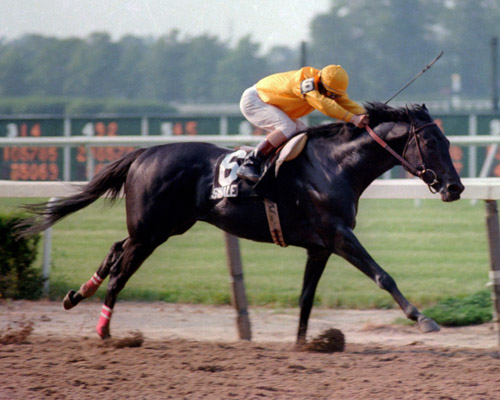 Pincay Jr. won the Kentucky Derby in 1984 aboard the brilliant Swale, and won the Belmont Stakes a total of three times. He also was victorious in seven Breeders’ Cup races, but one of his biggest achievements was setting a new all-time win record in 1999. He retired in 2003 with 9,530 career victories, making him the leader in wins among all jockeys. That record has since been surpassed by Russell Baze, but no other active jockey to date has come even close to capturing that many victories. Pincay Jr. is likely to hold the distinction of one of the world’s winningest jockeys for a long time to come. Pincay Jr. won the Kentucky Derby in 1984 aboard the brilliant Swale, and won the Belmont Stakes a total of three times. He also was victorious in seven Breeders’ Cup races, but one of his biggest achievements was setting a new all-time win record in 1999. He retired in 2003 with 9,530 career victories, making him the leader in wins among all jockeys. That record has since been surpassed by Russell Baze, but no other active jockey to date has come even close to capturing that many victories. Pincay Jr. is likely to hold the distinction of one of the world’s winningest jockeys for a long time to come.
Even more importantly, he left a positive impact on the sport. In addition to being awarded the George Woolf Memorial Award, he was voted the winner of the Mike Venezia Memorial Award, also given to jockeys who have a positive impact upon the sport both in and out of the saddle. Pincay Jr. was inducted into the Racing Hall of Fame in 1975. After his retirement, Hollywood Park created the Laffit Pincay Jr. Award, which was presented just as the awards he won during his career were: to anyone who has represented horse racing with integrity and had a positive impact on the sport. Past recipients included Zenyatta’s owners Jerry and Ann Moss.
Pincay Jr. continues to promote the sport in retirement, most recently appearing at Kentucky Downs on September 10th for the track’s Hall of Fame Jockeys’ Day, signing autographs to benefit the Permanently Disabled Jockeys’ Fund. His son, Laffit Pincay III, has gone into the racing industry as well, just as Pincay Jr. followed in his own father’s footsteps. Pincay III, like his father, has made his own name in the racing industry, working as a broadcaster for HRTV. It is a continuation of a tradition of excellence in the racing industry for the Pincay family.

Jockey World Member Sarah Troxell has been a racing enthusiast since she was a child, fueled by her mom's stories of Secretariat and Marguerite Henry and Walter Farley's books about horse racing. The sport fascinates Sarah for its compelling stories and all the twists and turns it can take. She is currently enrolled in the University of Kentucky's Equine Management program. Sarah spent a week last summer writing for the Saratoga Special, and is pursuing a career in racing journalism.
|
|
|
|
|
|
|
|
|
|
|
"Edgar Prado"
August 14, 2014 by Sarah Troxell
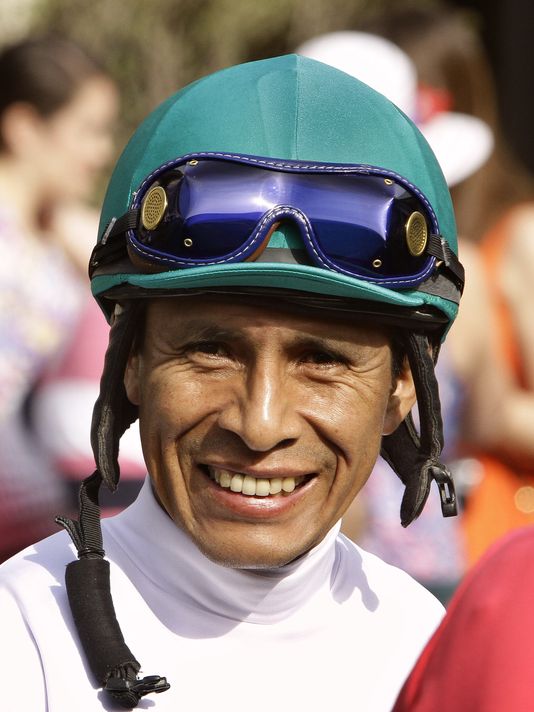 Edgar Prado may most recently have his name thought of simultaneously with that of Barbaro, since they teamed up to win the 2006 Kentucky Derby in an easy and dominating fashion. That triumph on a sun-splashed Saturday in May looked so easy because of Barbaro's talent, definitely; but it also was a perfect example of how much Prado excels at getting in sync with his mounts. While that was a professional highlight, it was only one more demonstration of all the dedication Prado has put into his career over the years. Any jockey can tell you that winning the Derby, even on the best horse, is never assured. Edgar Prado may most recently have his name thought of simultaneously with that of Barbaro, since they teamed up to win the 2006 Kentucky Derby in an easy and dominating fashion. That triumph on a sun-splashed Saturday in May looked so easy because of Barbaro's talent, definitely; but it also was a perfect example of how much Prado excels at getting in sync with his mounts. While that was a professional highlight, it was only one more demonstration of all the dedication Prado has put into his career over the years. Any jockey can tell you that winning the Derby, even on the best horse, is never assured.
Perhaps no horse would have stopped Barbaro that day, but a jockey who can skillfully maneuver through a large Derby field and get his horse in the best position to have running room, is a force to be reckoned with. Barbaro assuredly looked brilliant that day, as he had in all of his previous starts, winning them all. Prado had him in perfect position near the top of the stretch, on the outside and with unimpeded running room ahead, and he looked full of power as they rounded the corner to go down the stretch in the Kentucky Derby. He burst from the pack at the top of the stretch and then it was all Barbaro and Prado, drawing off to ever-widening margins. Prado settled into his mount's stride and a hand ride to the wire, leaving them flying home over 6 lengths ahead of the opposition. Watching that masterful ride, his rapport with the horse is evident. It was trainer Michael Matz' first Derby win, and Prado's as well. That year he also earned the Eclipse Award for Outstanding Jockey and won the Breeders' Cup Distaff aboard Round Pond, one of his four Breeders' Cup wins to date.
Winning the Derby is no doubt a career pinnacle for any jockey, but Prado’s path to the winners' circle that day began long before Barbaro was ever a notion in anyone's mind. Being a jockey seemed to run in his veins, and it didn't take long for him to excel at it. Edgar Prado was born in Peru into a racing family, as so many top jockeys have been. His father was an assistant trainer and Prado rode in his first race at the age of 16. He was on top of Peru's jockey standings less than a year after winning his first race. He didn't stay in Peru to ride very long after that, moving to the U.S. two years after starting his riding career.
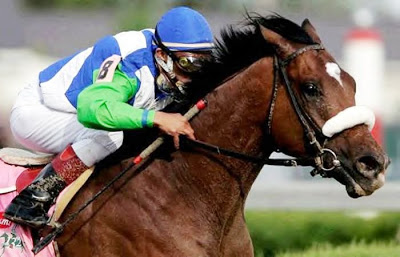 He quickly found a niche in the US as well, rising through the ranks and winning riding titles at several tracks, working his way up to riding on the tough New York circuit. He rode in his first Derby in 2002, taking 17th place, and rode in several others after that. His best finish in the Derby before he and Barbaro teamed up for victory was a third aboard Peace Rules. But no doubt his previous Derby rides and experience, as well as Barbaro's talent and the rapport they shared, helped propel them to their impressive win that day in 2006. It had, in part, been Prado's previous accomplishments that had landed him the mount on Barbaro early in 2006 and Prado was his only rider from then on. Of course, that put him aboard Barbaro in the Preakness when Barbaro suffered the broken hind leg; even then, though, Prado's bond with the horse and the sense he had in knowing that Barbaro had taken a bad step, saved him that day when he pulled him up immediately. While ultimately Barbaro was unable to recover, Prado was credited for his actions. A class act on the track and off, he displayed that same concern when he was in a race with Javier Castellano a few years ago. Castellano had lost his hold on the reins, and Prado kept his horse alongside as he leaned over and maneuvered the reins back into Castellano's hands, averting what could have been a bad spill. He quickly found a niche in the US as well, rising through the ranks and winning riding titles at several tracks, working his way up to riding on the tough New York circuit. He rode in his first Derby in 2002, taking 17th place, and rode in several others after that. His best finish in the Derby before he and Barbaro teamed up for victory was a third aboard Peace Rules. But no doubt his previous Derby rides and experience, as well as Barbaro's talent and the rapport they shared, helped propel them to their impressive win that day in 2006. It had, in part, been Prado's previous accomplishments that had landed him the mount on Barbaro early in 2006 and Prado was his only rider from then on. Of course, that put him aboard Barbaro in the Preakness when Barbaro suffered the broken hind leg; even then, though, Prado's bond with the horse and the sense he had in knowing that Barbaro had taken a bad step, saved him that day when he pulled him up immediately. While ultimately Barbaro was unable to recover, Prado was credited for his actions. A class act on the track and off, he displayed that same concern when he was in a race with Javier Castellano a few years ago. Castellano had lost his hold on the reins, and Prado kept his horse alongside as he leaned over and maneuvered the reins back into Castellano's hands, averting what could have been a bad spill.
It is moments like those that must have warranted consideration in awarding Prado the Mike Venezia Memorial Award, given by the New York Racing Association to jockeys who demonstrate extraordinary sportsmanship and citizenship. He also earned the George Woolf Memorial Award, awarded to the jockey “who demonstrates high standards of personal and professional conduct, on and off the racetrack,” according to the Santa Anita 2011/2012 media guide.
Prado won his first Triple Crown race in 2002, when Sarava captured the Belmont Stakes, and was elected into the Hall of Fame in 2008. He is currently riding at the elite Saratoga meet, picking up momentum once again after returning from an injury that sidelined him for a short time. With his rapport with the horse and a long string of professional excellence surrounding him, that momentum is definitely on the right track.

Jockey World Member Sarah Troxell has been a racing enthusiast since she was a child, fueled by her mom's stories of Secretariat and Marguerite Henry and Walter Farley's books about horse racing. The sport fascinates Sarah for its compelling stories and all the twists and turns it can take. She is currently enrolled in the University of Kentucky's Equine Management program. Sarah spent a week last summer writing for the Saratoga Special, and is pursuing a career in racing journalism.
|
|
|
|
|
|
|
|
|
|
|
"Rajiv Maragh"
July 15, 2014 by Sarah Troxell
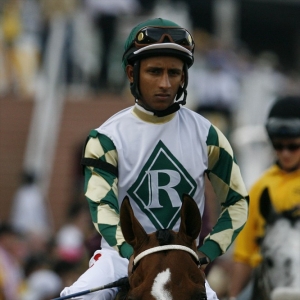 Rajiv Maragh was born in 1985 in Jamaica, and like quite a few others who took up the jockey profession, he followed in his father's footsteps when he got a leg up in that career. He began galloping horses at farms and then rode competitively in the U.S. after graduating from high school. Initially he rode for his father, who became a trainer after concluding his own jockey career. Rajiv Maragh was born in 1985 in Jamaica, and like quite a few others who took up the jockey profession, he followed in his father's footsteps when he got a leg up in that career. He began galloping horses at farms and then rode competitively in the U.S. after graduating from high school. Initially he rode for his father, who became a trainer after concluding his own jockey career.
Maragh rode his first winner in Florida in 2004, but getting good mounts didn't come easily. However, he showed promise and that caught retired Hall of Fame jockey Angel Cordero Jr's eye, who brought him to New York. From there, he became the leading apprentice at the Meadowlands that same year, and his career continued to blossom. The New York circuit is always tough, and for Cordero Jr. to take him there, confident he would excel, was an astute assessment of Maragh's ability right from the beginning of his professional career.
According to his NTRA biography, he studies the sport and the Daily Racing Form avidly and that attention to detail, and most assuredly learning from his family most of whom work in racing, has paid off, as seen by the achievements he has had in the time since he was an apprentice. He rode in his first Derby in 2010, and captured 14 graded stakes races in 2011 aboard many of that year's standout horses, such as Tizway and Caleb's Posse. Several of these wins came in major races on the New York circuit where Maragh rides most often. He is a regular at the elite Saratoga meets and in that track's winners circle.
Maragh first rode in the Breeders' Cup in 2009, hitting the board with Music Note in the Ladies' Classic. In 2011, he won the Breeders' Cup Mile on Caleb's Posse, notching his first win in a Breeders' Cup race. That same year, he was third in the Kentucky Derby on Mucho Macho Man, a standout in his division.
 Another highlight reel of his career came about due to his association with the Bradleys' homebred mare Groupie Doll. She was an absolute standout in the filly and mare sprint division while she raced. She dominated at Keeneland in her division, as at most tracks where she ran, and became somewhat of a fixture there during her race career. That was where I first encountered the future champion, who caught my eye when I paid a visit to the Bradleys' racing stable at Keeneland to see their retired champion Brass Hat. In the stall next to him was Groupie Doll, who caught my eye immediately with her presence. Mr. Bradley himself, always gracious with visitors, informed me that I should take her photo, saying something along the lines of she was going to be a champion. The rest was history: she and Maragh teamed up for a great string of victories that did earn her champion honors, including wins in the Breeders' Cup Filly and Mare Sprint in 2012 and 2013. (Photo Right Courtesy of Sarah Troxell: Rajiv Maragh aboard Groupie Doll, Keeneland, October 2012) Another highlight reel of his career came about due to his association with the Bradleys' homebred mare Groupie Doll. She was an absolute standout in the filly and mare sprint division while she raced. She dominated at Keeneland in her division, as at most tracks where she ran, and became somewhat of a fixture there during her race career. That was where I first encountered the future champion, who caught my eye when I paid a visit to the Bradleys' racing stable at Keeneland to see their retired champion Brass Hat. In the stall next to him was Groupie Doll, who caught my eye immediately with her presence. Mr. Bradley himself, always gracious with visitors, informed me that I should take her photo, saying something along the lines of she was going to be a champion. The rest was history: she and Maragh teamed up for a great string of victories that did earn her champion honors, including wins in the Breeders' Cup Filly and Mare Sprint in 2012 and 2013. (Photo Right Courtesy of Sarah Troxell: Rajiv Maragh aboard Groupie Doll, Keeneland, October 2012)
In addition to his 2012 Breeders' Cup victory aboard Groupie Doll, Maragh also won the Juvenile Sprint that year with Hightail. His success across the ranks is reflected year to year as well, as he is always among the top 20 jockeys in earnings, as ranked by Equibase.
With Saratoga just around the corner, Maragh looks poised to have another solid meet there. With the guidance he's had along the way from many in the racing industry and all the promise he showed early on and continues to show, it seems a given that he will continue to rise and accomplish greater and greater achievements in this sport.

Jockey World Member Sarah Troxell has been a racing enthusiast since she was a child, fueled by her mom's stories of Secretariat and Marguerite Henry and Walter Farley's books about horse racing. The sport fascinates Sarah for its compelling stories and all the twists and turns it can take. She is currently enrolled in the University of Kentucky's Equine Management program. Sarah spent a week last summer writing for the Saratoga Special, and is pursuing a career in racing journalism.
|
|
|
|
|
|
|
|
|
|
|
"Mike Smith"
June 16th, 2014 by Sarah Troxell
M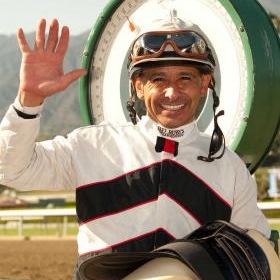 ention Mike Smith in racing circles and the name Zenyatta may also immediately come to mind, so successful was their partnership during the years Smith rode her. The two shared a bond that rippled throughout the lives of many who worked with the strapping bay mare or even just saw her race or dance across a track in anticipation of the competition to come. ention Mike Smith in racing circles and the name Zenyatta may also immediately come to mind, so successful was their partnership during the years Smith rode her. The two shared a bond that rippled throughout the lives of many who worked with the strapping bay mare or even just saw her race or dance across a track in anticipation of the competition to come.
Yet Mike Smith’s career has been a series of pinnacles and continuous success. He seems to constantly find new milestones to achieve, and all that he and Zenyatta accomplished together was just one more string of resume boosters in an incredibly impressive career.
Like many jockeys, Smith was practically born into racing as his dad was a jockey, and he began riding at a young age. He acquired his jockey’s license at the age of 16, and his career really began to take off in 1993, when he won the Preakness on Prairie Bayou and the Breeders’ Cup Mile on Lure. He had also become established as the top jockey in New York for several years by that time in number of wins.
The following year, he rode Horse of the Year Holy Bull to several notable wins and also won the Eclipse Award for Outstanding Jockey. He won several more Breeders’ Cup races, adding to an impressive tally that totals twenty wins to date in those events.
In 2000, Smith moved to California to ride the majority of the time, continuing to pick up mounts on top horses like Azeri. He was also awarded the George Woolf Memorial Jockey Award that year for demonstrating first-rate personal and professional excellence.
In 2003, Smith was inducted into the Racing Hall of Fame, and was still riding the crest of professional achievements yet to be realized.
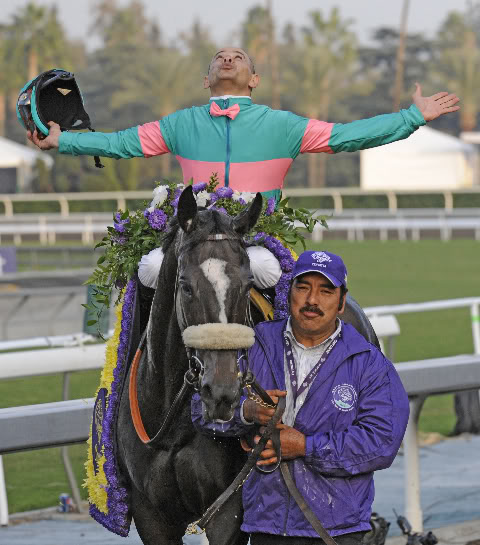 In 2005, he won his first Kentucky Derby aboard Giacomo. The year 2008 marked his first Breeders’ Cup win aboard Zenyatta in the Ladies’ Classic. Attending that event, I recall being impressed by the way she danced across the track and how imposing she looked. She was running against many top older mares, but they proved no match for her. The following year, her connections bypassed the Ladies’ Classic for the Classic, and she was still about mid-pack deep in the homestretch, finally bursting free practically in the shadow of the wire with a huge rushing charge. That win made her the first filly or mare to capture the Breeders’ Cup Classic in its history, and Smith’s fondness for her after the race was clearly evident as he hugged her neck. In 2005, he won his first Kentucky Derby aboard Giacomo. The year 2008 marked his first Breeders’ Cup win aboard Zenyatta in the Ladies’ Classic. Attending that event, I recall being impressed by the way she danced across the track and how imposing she looked. She was running against many top older mares, but they proved no match for her. The following year, her connections bypassed the Ladies’ Classic for the Classic, and she was still about mid-pack deep in the homestretch, finally bursting free practically in the shadow of the wire with a huge rushing charge. That win made her the first filly or mare to capture the Breeders’ Cup Classic in its history, and Smith’s fondness for her after the race was clearly evident as he hugged her neck.
That is probably one of the qualities that helps make Smith such an excellent rider; he seems to find that bond with the mounts he regularly rides. His fondness for her also showed when he blamed himself for her narrow loss to Blame in the 2010 Breeders’ Cup Classic, yet there was no shame in her barely getting edged out on the wire. Though she didn’t retire undefeated, in barely losing that race and not giving up, she showed a lot of heart.
While Zenyatta would be a horse that could help propel many jockeys’ careers to places they had never been, Smith still had new pinnacles to reach once she retired. He became champion mare Royal Delta’s jockey for part of her career, and together they won the 2012 Ladies’ Classic at Santa Anita. Earlier in the same year, he also visited the winners’ circle for the 5000th time in his career.
Smith picked up several more Breeders’ Cup wins in 2013, and also won that year’s Belmont aboard Palace Malice. This year he is currently ranked fourth among all jockeys for earnings, and the future continues to shine brightly. No doubt Smith will still find new milestones to reach in a career already full of incredible achievements.

Jockey World Member Sarah Troxell has been a racing enthusiast since she was a child, fueled by her mom's stories of Secretariat and Marguerite Henry and Walter Farley's books about horse racing. The sport fascinates Sarah for its compelling stories and all the twists and turns it can take. She is currently enrolled in the University of Kentucky's Equine Management program. Sarah spent a week last summer writing for the Saratoga Special, and is pursuing a career in racing journalism.
|
|
|
|
|
|
|
|
|
|
 Brian Hernandez, Jr. was born in 1985 in Lafayette, Louisiana, and followed in his father’s career path when he began his jockey career in Louisiana, getting his first win at the age of 18 at Delta Downs. Racing is a family profession, as Hernandez Jr. also has a sister and brother who have taken that path. Growing up with horses and riding at Louisiana’s bush tracks also helped launch his career, as it did for many jockeys from that region. Brian Hernandez, Jr. was born in 1985 in Lafayette, Louisiana, and followed in his father’s career path when he began his jockey career in Louisiana, getting his first win at the age of 18 at Delta Downs. Racing is a family profession, as Hernandez Jr. also has a sister and brother who have taken that path. Growing up with horses and riding at Louisiana’s bush tracks also helped launch his career, as it did for many jockeys from that region. The year after beginning his career, he received the Eclipse Award for Outstanding Apprentice Jockey, and his success was just beginning.
Hernandez Jr. is now a regular on the Kentucky circuit, and when eventual Horse of the Year and Preakness winner Rachel Alexandra began racing at Churchill Downs and Keeneland, he was her pilot for five of those starts, with two wins.
Brian Hernandez Jr's wife also came from a family with a strong racing background. Jamie Radosevich-Hernandez is the daughter of racehorse trainer Jake Radosevich. Growing up around a racing stable fueled her passion for the sport as well, which led to working as an assistant trainer and as a photographer for Reed Palmer Photography. It was during an assignment for Reed Palmer that she captured the moment Horse of the Year Wise Dan won the Firecracker Handicap at Churchill Downs in the midst of an intense fall of rain. This photo earned her the Eclipse Award for Photography in 2013.
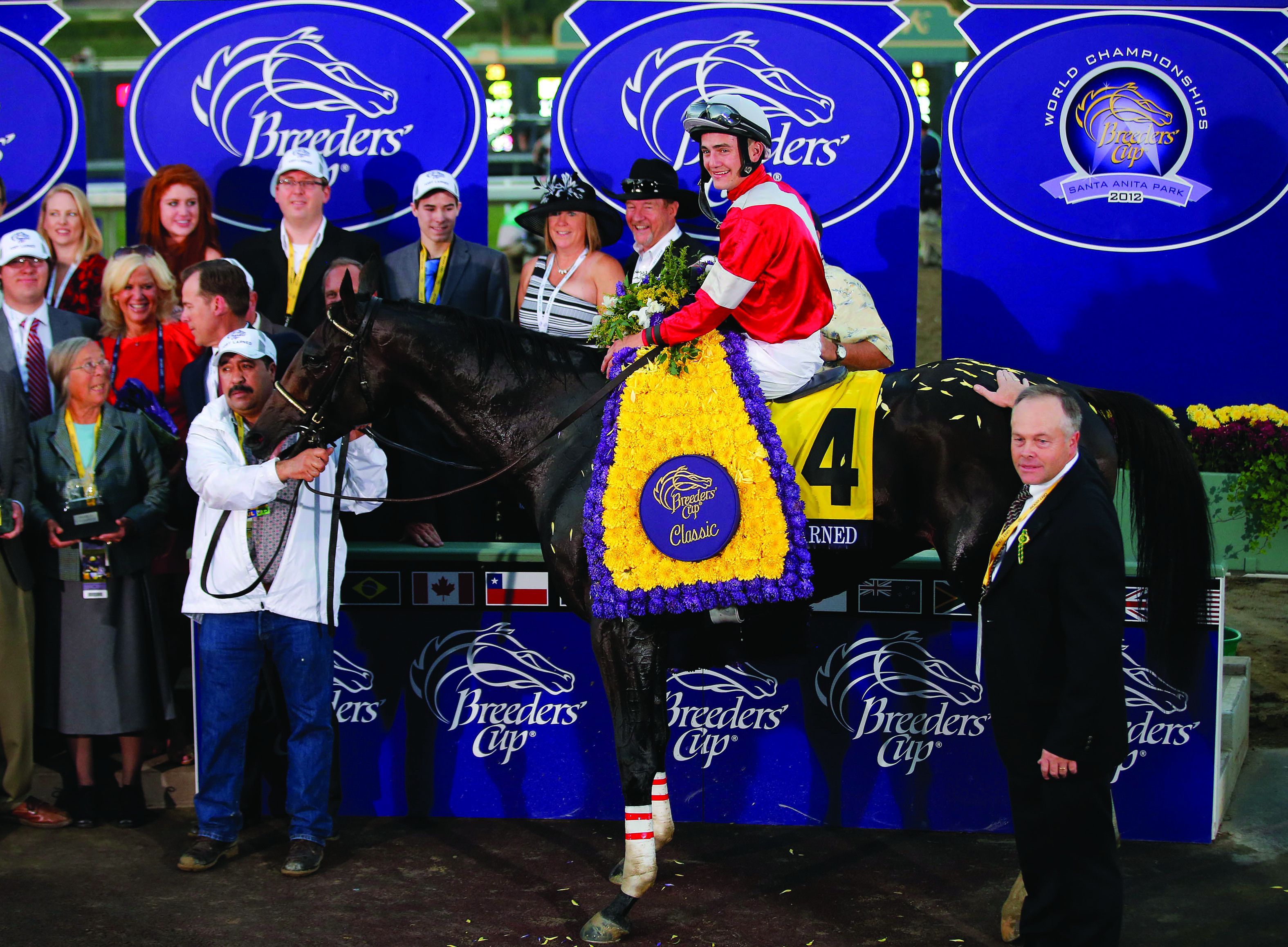 Her husband also reached a new career height when he became Fort Larned’s regular rider, especially when they won the Breeders’ Cup Classic in 2012, on Hernandez Jr.’s twenty-seventh birthday. It was one of those dream outcomes that helps keep racing so riveting, as it was his first win in a Breeders’ Cup race, and he captured the biggest one of all, the culmination of a stellar two days’ worth of racing. He and Fort Larned bested the hard-trying Mucho Macho Man, who had to settle for second, and other top horses such as Game On Dude, Flat Out, and To Honor and Serve that day. What a grand birthday gift that had to be for anyone involved in racing, to win at the highest level on that day. He and Fort Larned also teamed up for an authoritative win in the Stephen Foster Handicap under lights at Churchill Downs the following year, drawing away by more than six lengths at the wire. It was aboard Fort Larned that Hernandez Jr. also gained his first Grade 1 win; that is the kind of horse that helps boost a jockey’s career. Her husband also reached a new career height when he became Fort Larned’s regular rider, especially when they won the Breeders’ Cup Classic in 2012, on Hernandez Jr.’s twenty-seventh birthday. It was one of those dream outcomes that helps keep racing so riveting, as it was his first win in a Breeders’ Cup race, and he captured the biggest one of all, the culmination of a stellar two days’ worth of racing. He and Fort Larned bested the hard-trying Mucho Macho Man, who had to settle for second, and other top horses such as Game On Dude, Flat Out, and To Honor and Serve that day. What a grand birthday gift that had to be for anyone involved in racing, to win at the highest level on that day. He and Fort Larned also teamed up for an authoritative win in the Stephen Foster Handicap under lights at Churchill Downs the following year, drawing away by more than six lengths at the wire. It was aboard Fort Larned that Hernandez Jr. also gained his first Grade 1 win; that is the kind of horse that helps boost a jockey’s career.
With over 1,300 wins to date, talent like his and racing in his veins, Hernandez Jr. forged that path to acclaim with Fort Larned, and is a regular visitor to the winners' circle.

Jockey World Member Sarah Troxell has been a racing enthusiast since she was a child, fueled by her mom's stories of Secretariat and Marguerite Henry and Walter Farley's books about horse racing. The sport fascinates Sarah for its compelling stories and all the twists and turns it can take. She is currently enrolled in the University of Kentucky's Equine Management program. Sarah spent a week last summer writing for the Saratoga Special, and is pursuing a career in racing journalism.
|
|
|
|
|
|
|
|
|
|
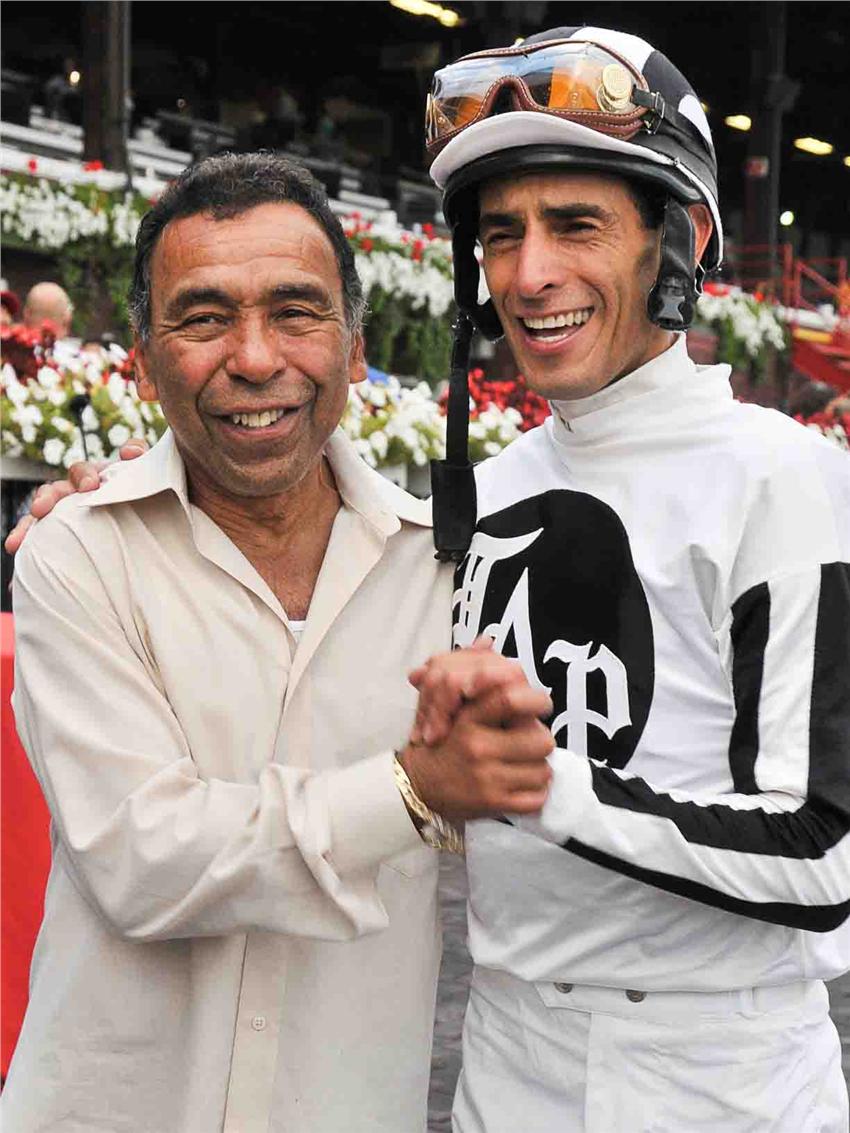
Hall of Fame jockey John Velazquez, popularly known as “Johnny V,” was born in Puerto Rico in 1971 and got his riding career under way by attending a jockey school there. Fellow Hall of Fame rider Angel Cordero Jr. (shown left with Velazquez) was an influential force in Velazquez’ career once Velazquez moved to the U.S. and Cordero has been his agent for over ten years.
Velazquez has been a fixture in many top races, winning the 2007 Belmont on filly Rags to Riches and more recently in 2012 on Union Rags. He also captured the 2011 Kentucky Derby aboard Animal Kingdom, and serves as an ambassador for the sport out of the saddle as well; among other things, he is currently the chairman of the Jockeys’ Guild. In 2009 Velazquez won the George Woolf Memorial Jockey Award, described by the Jockeys’ Guild website as being awarded to riders “whose careers and personal character earn esteem for the individual and the sport of Thoroughbred horse racing” and in 2012 he was inducted into the National Museum of Racing and Hall of Fame. Velazquez has also regularly been among the top riders by races won in New York, and ridden such top horses as Wise Dan, In Lingerie, Roses in May (winning the Dubai World Cup aboard him), to mention just a few.
 Velazquez reached a new milestone on March 22, 2014, in the Spiral Stakes as he went postward on We Miss Artie, a colt seeking a berth in the Kentucky Derby. Not only had he recently returned to the races after an injury sustained during the 2013 Breeders' Cup card which required the removal of his spleen, but he also won this race aboard We Miss Artie in a late closing rush to just nip it at the wire. In the process, Velazquez became the first North American jockey to reach $300 million in earnings. Velazquez reached a new milestone on March 22, 2014, in the Spiral Stakes as he went postward on We Miss Artie, a colt seeking a berth in the Kentucky Derby. Not only had he recently returned to the races after an injury sustained during the 2013 Breeders' Cup card which required the removal of his spleen, but he also won this race aboard We Miss Artie in a late closing rush to just nip it at the wire. In the process, Velazquez became the first North American jockey to reach $300 million in earnings.
No matter where he rides, his commitment to the sport and prowess on horseback allows Velazquez to reach new milestones time after time. Seeing his good humor and kindness to fans, even after the course of a long Derby day when his family is waiting for him to wrap up, is just one of many reasons Velazquez is so well regarded among his peers and racing attendees alike.

Jockey World Member Sarah Troxell has been a racing enthusiast since she was a child, fueled by her mom's stories of Secretariat and Marguerite Henry and Walter Farley's books about horse racing. The sport fascinates Sarah for its compelling stories and all the twists and turns it can take. She is currently enrolled in the University of Kentucky's Equine Management program. Sarah spent a week last summer writing for the Saratoga Special, and is pursuing a career in racing journalism.
|
|
|
|
|
|
|
|
|
|
|
"Calvin Borel"
March 15th, 2014 by Sarah Troxell
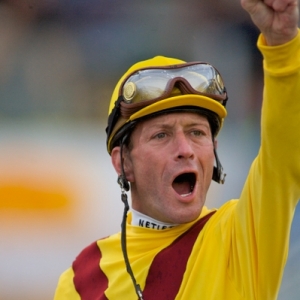
Calvin Borel began his career at a young age on the bush tracks of Louisiana, like many current top jockeys did. His career was aided by his older brother Cecil Borel, a Thoroughbred trainer. In fact, it was his brother who gave him the tip that he is famously known for and has led to much of his success in races from the lower ranks to those at the very top of the game. That tip was to stay on the rail and cover the shortest distance around the track. Reading about his propensity for that route, an inclination that earned him the nickname “Bo-Rail,” is altogether different from seeing it. With an impeccable sense of how a hole that may look too narrow is still one that he can safely guide his mount through, it makes him seem fearless yet not reckless, even in a sport that requires split-second decisions and the ability to take quick advantage of opportunities as they open up. It’s not even that other jockeys wouldn’t take that chance themselves or would let him “steal” races that way. It’s been said they know he’s going to go for the rail, but one can't get through every time.
Borel has downplayed the effect however, in a way that endears him to many racing fans. He stays humble even with all of his fairly recent success.
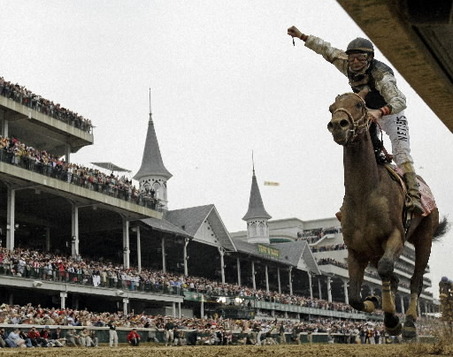 Most notably, he used that tactic with Mine That Bird to win the Kentucky Derby in 2009. The gelding, a 50-1 shot, snuck through on the rail in deep stretch and left the field well behind in his wake. It capped off an incredible weekend at Churchill Downs for Borel. The day before, he had piloted superstar filly Rachel Alexandra to an amazing winning margin of over 20 lengths in the Kentucky Oaks. Two weeks later, the pair teamed up again in the Preakness and prevailed there as well, making Rachel Alexandra the first filly to wear the blanket of Black-eyed Susans in 85 years. It was yet another highlight in the upward trajectory of Borel’s career since his first Derby win on Street Sense in 2007, as all his hard work and dedication to the sport began to really shine through on a national stage. Most notably, he used that tactic with Mine That Bird to win the Kentucky Derby in 2009. The gelding, a 50-1 shot, snuck through on the rail in deep stretch and left the field well behind in his wake. It capped off an incredible weekend at Churchill Downs for Borel. The day before, he had piloted superstar filly Rachel Alexandra to an amazing winning margin of over 20 lengths in the Kentucky Oaks. Two weeks later, the pair teamed up again in the Preakness and prevailed there as well, making Rachel Alexandra the first filly to wear the blanket of Black-eyed Susans in 85 years. It was yet another highlight in the upward trajectory of Borel’s career since his first Derby win on Street Sense in 2007, as all his hard work and dedication to the sport began to really shine through on a national stage.
Coming back to the Derby in 2010 on Super Saver, he captured that renewal of the race as well. It was a rare achievement to capture three Kentucky Derby's in four years, and in 2013 Borel found himself reaching another pinnacle in racing with his induction into the Hall of Fame. His brother hugged him as he made his way to the stage, there for him as he’d been from the beginning, and his wife went to the stage with him, to help him say the words emotion made difficult to get out. His induction and the recognition of his hard work in the sport was a well-received choice. It was touching to hear his speech and witness the hugs between him and his brother, and to hear Borel's gratitude for the trainers and horses who had helped him find his way to the stage that day. Rachel Alexandra featured prominently in his induction video and speech as well, offering a glimpse into the heartfelt applause that will greet her own induction one day.
Borel left the stage after his induction to a standing ovation, wearing the Hall of Fame jacket that trainer Carl Nafzger had helped him into, after also giving him a leg up on Street Sense and many other mounts. The sky is still the limit and no doubt Borel has new pinnacles to reach, and a lot of them will probably still be found in the classic “Bo-rail” style.

Jockey World Member Sarah Troxell has been a racing enthusiast since she was a child, fueled by her mom's stories of Secretariat and Marguerite Henry and Walter Farley's books about horse racing. The sport fascinates Sarah for its compelling stories and all the twists and turns it can take. She is currently enrolled in the University of Kentucky's Equine Management program. Sarah spent a week last summer writing for the Saratoga Special, and is pursuing a career in racing journalism.
|
|
|
|
|
|
|
|
|
|
|
"Gary Stevens"
February 15th, 2014 by Sarah Troxell
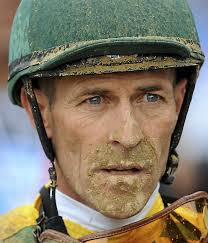 Gary Stevens, like many jockeys, began riding at a very young age, and channeled those early riding experiences into a love for horse racing when he rode his first Thoroughbred at the age of 12, according to his autobiography. It was the beginning of a deep love for the sport and the thrill of being involved with fast horses and the track which many racing enthusiasts know so well. Gary Stevens, like many jockeys, began riding at a very young age, and channeled those early riding experiences into a love for horse racing when he rode his first Thoroughbred at the age of 12, according to his autobiography. It was the beginning of a deep love for the sport and the thrill of being involved with fast horses and the track which many racing enthusiasts know so well.
Stevens rode that early introduction to a top career in the saddle, with multiple wins in Triple Crown races and other top races, and induction into the Hall of Fame. When he hung up his tack in 2005 after guiding horses like Serena’s Song, Point Given, and Silver Charm to the winner’s circle in elite races time after time, he took up announcer duties for racing networks.
Yet the passion for the sport, for the thrill of riding, never really let go. Knee pain had been something Stevens battled throughout his career and it had previously led him to temporarily retire once before 2005. The love for the sport however is difficult to shake, making it hard to watch from the sidelines. Stevens wanted to return to riding, and began an intense training program which saw him return to the saddle in 2013 with the aim of rising to the top of the sport he once dominated. That rise didn’t take long, and it was inspiring to see the return of a great jockey, with all of the competitive fire and skill still deeply rooted inside him.
Anyone who loves racing, from railbirds to trainers to jockeys, can understand that drive to be involved as much as possible. Racing is a rollercoaster of excitement with ups and downs, twists and turns, that is fascinating to watch unfold. It is hard to walk away from, and those who do follow the sport need no explanation for why Stevens decided to return. It’s all about passion, dreams, and following a calling.
Incredibly, perhaps even beyond what he had anticipated – although he returned with the goal of riding elite races and top horses – Stevens won the 2013 Preakness aboard Oxbow. His smile nearing the wire said it all: elation tinged by a bit of disbelief, perhaps. That is what is so great about this sport: the improbable becomes possible, often in the most thrilling, dramatic fashion.
From there, it got even better. Stevens achieved a career first with a well-timed ride aboard trainer Kathy Ritvo’s horse of a lifetime, Mucho Macho Man, when they captured the Breeders’ Cup Classic together.
It was a storybook outcome for all involved. Stevens told Kathy Ritvo after the Classic win that he loved the horse and she had made an old man very happy. It was redemption for Mucho Macho Man, for his loss to Fort Larned in last year’s Breeders’ Cup Classic, and for Ritvo, the honor of becoming the first female trainer to win the Classic.
Now, 2014 looks to be another banner year, as Stevens has already ridden Mucho Macho Man to an impressive 14-length win in the Sunshine Millions Classic in January, and holds the mount on his Breeders’ Cup Distaff winner Beholder, as well as on the promising 3-year-old, Candy Boy, who is being aimed down the Derby trail.
In some ways, this is just the beginning for Gary Stevens. He clearly has more pinnacles to reach, and to see a top jockey return in such successful fashion is great for the sport. A whole new generation of fans have come along since he retired, including Stevens’ young daughter. They can say they saw the great rider return to the saddle as one of the very best, riding among the best.

Jockey World Member Sarah Troxell has been a racing enthusiast since she was a child, fueled by her mom's stories of Secretariat and Marguerite Henry and Walter Farley's books about horse racing. The sport fascinates Sarah for its compelling stories and all the twists and turns it can take. She is currently enrolled in the University of Kentucky's Equine Management program. Sarah spent a week last summer writing for the Saratoga Special, and is pursuing a career in racing journalism.
|
|
|
|
|
|
|
|
|
|
|
"William Shoemaker"
May 8th, 2013 by Michaela Heair
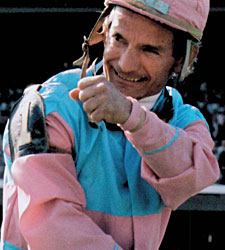 William "Bill" Lee Shoemaker was born in the town of Fabens, Texas. His minute size proved an advantage as he went on to become a giant in thoroughbred horse racing, despite being a high school dropout from El Monte High School. His career as a jockey began in his teenage years, with his first professional mount coming on March 19, 1949. The first of his eventual 8,833 career victories came a month later, on April 20, aboard a racer named Shafter V, at the Golden Gate Fields in Albany, California. In 1951, he won the George Woolf Memorial Jockey Award; 30 years later he won the Eclipse Award for Outstanding Jockey in the United States. William "Bill" Lee Shoemaker was born in the town of Fabens, Texas. His minute size proved an advantage as he went on to become a giant in thoroughbred horse racing, despite being a high school dropout from El Monte High School. His career as a jockey began in his teenage years, with his first professional mount coming on March 19, 1949. The first of his eventual 8,833 career victories came a month later, on April 20, aboard a racer named Shafter V, at the Golden Gate Fields in Albany, California. In 1951, he won the George Woolf Memorial Jockey Award; 30 years later he won the Eclipse Award for Outstanding Jockey in the United States.
Shoemaker won 11 Triple Crown races during his career, but the Crown itself was not a part of his achievements. His individual wins in the races were as follows - Kentucky Derby: Swaps (1955), Tomy Lee (1959), Lucky Debonair (1965) and Ferdinand (1986) Preakness Stakes: Candy Spots (1963) and Damascus (1967) Belmont Stakes: Gallant Man (1957), Sword Dancer (1959), Jaipur (1962), Damascus (1967) and Avatar (1975).
Two of Shoemaker's most noted rides came in the Kentucky Derby. He lost the 1957 Kentucky Derby aboard Gallant Man when he stood up in the stirrups too soon, having misjudged the finish line. Gallant Man finished second to Iron Liege, ridden by Bill Hartack. In the 1986 Kentucky Derby, Shoemaker became the oldest jockey ever to win the race aboard the 18-1 outsider Ferdinand. The following year, he rode Ferdinand to a victory over Alysheba in the Breeders' Cup Classic; Ferdinand later captured Horse of the Year honors. Shoemaker rode the popular California horse, Silky Sullivan, about which he is quoted as saying: "You just had to let him run his race ... and if he decided to win it, you'd better hold on because you'd be moving faster than a train."
 The Los Angeles Times quoted Bill Shoemaker as saying that Spectacular Bid was the best he rode. The Los Angeles Times quoted Bill Shoemaker as saying that Spectacular Bid was the best he rode.
When Shoemaker earned his 6,033rd victory in September of 1970, he broke jockey Johnny Longden's record. In 1999, Shoemaker's own record of 8,833 career victories was broken by Panamanian-born Laffit Pincay Jr.; the record is currently held by Russell Baze. Win number 8,833, Shoemaker's last, came at Gulfstream Park, Florida on January 20, 1990 aboard Beau Genius. Two weeks later, on February 3, Shoemaker rode his last race on Patchy Groundfog at Santa Anita Park; he finished 4th to Eddie Delahoussaye in front of a record crowd.
All told, Bill Shoemaker rode in a record 40,350 races. In 1990, he was voted the Mike Venezia Memorial Award for "extraordinary sportsmanship and citizenship."
.jpg)
Jockey World Member Michaela Heair is a high school student and ambitious individual. In her own words, "I have dreams and goals to achieve in life. I will work to the bone to have a successful racing career. I don't expect anything to be handed to me, I WANT to work to earn the things I desire. These things are: to be the best jockey of my ability, have a happy life doing what I love, and make history in racing."
|
|
|
|
|
|
|
|
|
|
|
"Chris Antley"
April 8th, 2013 by Michaela Heair
 Chris Antley was born on January 6, 1966. He was born in Fort Lauderdale, Florida but grew up in Elloree, South Carolina. He left school at sixteen to ride racehorses at Pimlico Race Course in Baltimore, Maryland. Antley's first win came on a horse named Vaya Con Dinero. Not long after, he left Maryland to race in New York and New Jersey and at the age of 18, he was the U.S. Champion Jockey by wins with 469. Chris Antley was born on January 6, 1966. He was born in Fort Lauderdale, Florida but grew up in Elloree, South Carolina. He left school at sixteen to ride racehorses at Pimlico Race Course in Baltimore, Maryland. Antley's first win came on a horse named Vaya Con Dinero. Not long after, he left Maryland to race in New York and New Jersey and at the age of 18, he was the U.S. Champion Jockey by wins with 469.
In the 1980s, Antley spent time in a substance abuse clinic. After he overcame his obstacles he continued his journey on the racetrack. In 1987 he became the first rider to win 9 races on 9 different horses in a single day, and in 1989, set another record when he won at least one race a day for 64 consecutive days. In 1990 Antley moved his tack to California.

In 1991 Antley rode Strike the Gold to victory in the Kentucky Derby and the '90s saw some of the best days he would ever experience on the racetrack. He went on to win several major stakes during the final years of his career; the Futurity Stakes, Blue Grass Stakes, Alabama Stakes, and the Santa Anita Handicap are just a few!
In 1997 he temporarily retired to deal with weight and substance problems. In 1999 Antley returned to ride the D. Wayne Lukas trained Charismatic, winning the Kentucky Derby and Preakness Stakes together that year. However, in the 1999 Belmont Stakes, Charismatic finished third after injuring his leg in the stretch run.
Chris Antley had both a very bright and dark career, but he brought things to racing that only he was capable of brining. He lives on as a legend and will never be forgotten for the things he achieved.
.jpg)
Jockey World Member Michaela Heair is a high school student and ambitious individual. In her own words, "I have dreams and goals to achieve in life. I will work to the bone to have a successful racing career. I don't expect anything to be handed to me, I WANT to work to earn the things I desire. These things are: to be the best jockey of my ability, have a happy life doing what I love, and make history in racing."
|
|
|
|
|
|
|
|
|
|
|
"Steve Cauthen"
March 14th, 2013 by Kayla Jarvinen
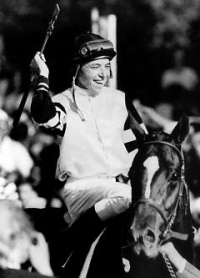 Crouched low over a bale of hay in the loft of his parent’s barn, a pair of reins clutched in his hands, switching a whip effortlessly from one hand to the other as time and time again he comes with-in an 1/8 of an inch of the mark he has carefully made on the hay. Hour after hour, day after day, week after week he could be found crouched over those same hay bales, concentrating on something only he could see. Years later, as he guided Affirmed to victory in the third leg of the Triple Crown, it would be second nature to him. Crouched low over a bale of hay in the loft of his parent’s barn, a pair of reins clutched in his hands, switching a whip effortlessly from one hand to the other as time and time again he comes with-in an 1/8 of an inch of the mark he has carefully made on the hay. Hour after hour, day after day, week after week he could be found crouched over those same hay bales, concentrating on something only he could see. Years later, as he guided Affirmed to victory in the third leg of the Triple Crown, it would be second nature to him.
Steve Cauthen, born on May 1, 1960 in Covington, Kentucky grew up around horses. He was a familiar face at the track, often accompanying his father, a farrier, on his rounds around the barns. On May 12, 1976 Cauthen made his debut at Churchill Downs; he finished second-to-last. His first win wasn’t long in coming though as he won his first race less than a week later at River Downs. From then on the winner’s circle was to be a familiar place to the kid who would become known as “Stevie Wonder.”
Although he quickly rose to the top, Cauthen never lost his hard working, humble attitude. In 1977 he was the nation’s leading rider in wins with 487. That same year he passed the $6 million mark in purse money earned, making him the first jockey to do so in one season. He also won an array of awards that year including the Eclipse Award for Apprentice Jockey and the Eclipse Award for Outstanding Jockey; the first and only jockey to ever receive both awards in the same year. He was a natural, well known by many. The following year, 1978, was the year that would cement him in racing history forever. That was the year Cauthen rode Affirmed to victory in all three Triple Crown races, winning the Belmont by a mere head in the famous Affirmed/Alydar rivalry, and becoming the last pair to win the Triple Crown to date. Cauthen was only 17-years-old.
 Small and light up to that time, Cauthen grew to 5‘6”, sparking a career long battle to make weight. In 1979 he moved his tack to England, where the weights are higher. He became a huge success, winning the first race he rode there on April 7, 1979. His list of accomplishments include winning ten English Classic races - the 2,000 Guineas, the Epsom Derby twice, and the St. Leger Stakes three times, among others. He rode the European Horse of the Year to major victories in 1989 and won the title of British Champion Jockey three times. Cauthen also remains the only jockey to win the Kentucky, Epsom, Irish, French, and Italian Derby’s. Aside from meeting and riding for the Royal family he rode races in Ireland, England, France, Japan, Hong Kong, Norway, Italy, Iceland, Australia, and South Africa. Small and light up to that time, Cauthen grew to 5‘6”, sparking a career long battle to make weight. In 1979 he moved his tack to England, where the weights are higher. He became a huge success, winning the first race he rode there on April 7, 1979. His list of accomplishments include winning ten English Classic races - the 2,000 Guineas, the Epsom Derby twice, and the St. Leger Stakes three times, among others. He rode the European Horse of the Year to major victories in 1989 and won the title of British Champion Jockey three times. Cauthen also remains the only jockey to win the Kentucky, Epsom, Irish, French, and Italian Derby’s. Aside from meeting and riding for the Royal family he rode races in Ireland, England, France, Japan, Hong Kong, Norway, Italy, Iceland, Australia, and South Africa.
Steve Cauthen retired in 1993 with a total of 2,794 wins and was inducted into the National Museum of Racing’s Hall of Fame in 1994. He married his wife, Amy, in 1992 and has three daughters. Ironically enough, after he retired, Cauthen went back home to Kentucky where he settled down on the farm he named Dreamfields, which he had purchased 14 years prior with money he earned riding. He now runs a breeding and training operation there.
.jpg)
Jockey World Member Kayla Jarvinen is 19-years-old and pursuing a riding career in horse racing. She enjoys meeting new friends in this wonderful industry, and loves networking and promoting our sport in a positive light to new and "old" fans alike. She also assists Frankie with Jockey World and its projects.
|
|
|
|
|
|
|
|
|
|
|
"Jerry Bailey"
February 7th, 2013 by Michaela Heair
 "Jerry Bailey calls for everything Cigar has!" "Jerry Bailey calls for everything Cigar has!"
These words were spoken just moments before Jerry Bailey and Cigar were being applauded for their victory in the '95 Breeders' Cup Classic. This is just one of the many highlights from through-out Bailey's career. Most all racing fans know of his phenomenal achievements aboard Cigar, but there's much more to the story than just that.
Jerry D. Bailey was born on August 29, 1957 in the Lone Star state. The birth of this champion took place in Dallas, Texas. While in his early teen years he began his journey to become a jockey. Little did he know that years later, he would be inducted into Horse Racing's Hall of Fame.
Bailey's first mount came aboard a horse named Pegged Rate; he did not come out of this race successful. It took just one more race for him to get acquainted with the winner's circle. His first winning photo was taken on only his second career mount, Fetch, at Sunland Park.
Bailey is no stranger when it comes to records in our Sport of Kings. He notched 15 wins in Breeders' Cup races, of which 5 came in the Breeders' Cup Classic. He also went on to win the Kentucky Derby, Preakness Stakes, and Belmont Stakes twice each. He was soon rewarded for his skills on the track. When it was time for the Eclipse Awards to be handed out, one jockey was taking home the Eclipse Award for Outstanding Jockey. Jerry Bailey not only took this award home once, but 7 times ('95, '96, '97, '00, '01, '02, & '03"). Among other awards Bailey won, was the George Woolf Memorial Jockey Award, Mike Venezia Memorial Award, and the Big Sport of Turfdom Award.
Success did not come easy for Bailey though. There were hardships he had to overcome, but he always did. For people to get an inside look he wrote Against The Odds. The book gives a clearer understanding of the problems that affected his career to a certain degree.
When time for retirement came for Bailey, he was 48-years-old. He achieved so many things that several jockeys don't even stick around for. Bailey is widely known in the world of racing, and you can still hear his voice and see his face in the racing media.
.jpg)
Jockey World Member Michaela Heair is a high school student and ambitious individual. In her own words, "I have dreams and goals to achieve in life. I will work to the bone to have a successful racing career. I don't expect anything to be handed to me, I WANT to work to earn the things I desire. These things are: to be the best jockey of my ability, have a happy life doing what I love, and make history in racing."
|
|
|
|
|
|
|
|
|
|
|
"Jesus Castanon"
January 7th, 2012 by Michaela Heair
 Jesus Lopez Castanon was brought into this world on March 4, 1973 in Mexico City, Mexico. He was raised into the atmosphere of the track. He was the son of a horse trainer and his two siblings were also jockeys located in Mexico. Castanon began his racing career at Agua Caliente Racetrack in the year of 1989. Before long, he found himself traveling to the United States and later that year, he won his first stakes race at Del Mar (Torrey Pines Stakes). Jesus Lopez Castanon was brought into this world on March 4, 1973 in Mexico City, Mexico. He was raised into the atmosphere of the track. He was the son of a horse trainer and his two siblings were also jockeys located in Mexico. Castanon began his racing career at Agua Caliente Racetrack in the year of 1989. Before long, he found himself traveling to the United States and later that year, he won his first stakes race at Del Mar (Torrey Pines Stakes).
Castanon is well known at tracks across the country because he brings his top game with him wherever he has mounts. He became widely recognized as Shackleford's jockey; the pair experienced success together at the top levels of racing. In 2011, Castanon and Shack finished 4th in the Kentucky Derby. Two weeks later, they came back to redeem themselves with a victory in the Preakness. The Belmont Stakes was a different race for them, they finished a gut wrenching fifth. It seemed as if Shackleford and Castanon were beginning to lose their touch until they rallied in 2012, showing their grit in the Met Mile. After their winning photo in the Met Mile, the two began to prepare for the Breeders' Cup.
The Breeders' Cup is always full of surprises, and it brought shock when the pair finished seventh in last year's edition of the Dirt Mile. After the Breeders' Cup, it was time for Shackleford to move on with his career. He went out a winner with Castanon on his back following a dominating victory in the Clark Handicap.
The year 2013 has not brought a win for Castanon just yet, but he has had 2 seconds and 1 third. With a career that has seen him ride over 16,620 races with 2,148 victories and overall earnings of $45,489,524 to date, it won't be long until we see Jesus Castanon in the winners' circle once again.
.jpg)
Jockey World Member Michaela Heair is a high school student and ambitious individual. In her own words, "I have dreams and goals to achieve in life. I will work to the bone to have a successful racing career. I don't expect anything to be handed to me, I WANT to work to earn the things I desire. These things are: to be the best jockey of my ability, have a happy life doing what I love, and make history in racing."
|
|
|
|
|
|
|
|
|
|
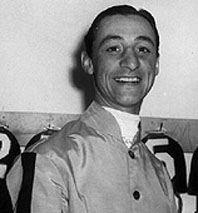 At the start of every year the majority of our focus is on the 3-year-old Thoroughbreds as they prepare for the trial that is the Triple Crown. There is also another factor that we strongly consider, the jockeys in the irons. Horse racing has seen several jockeys bloom during the Kentucky Derby, Preakness, and Belmont Stakes. However, one jockey in particular still has a firm grasp on his spot in Triple Crown history. At the start of every year the majority of our focus is on the 3-year-old Thoroughbreds as they prepare for the trial that is the Triple Crown. There is also another factor that we strongly consider, the jockeys in the irons. Horse racing has seen several jockeys bloom during the Kentucky Derby, Preakness, and Belmont Stakes. However, one jockey in particular still has a firm grasp on his spot in Triple Crown history.
Eddie Arcaro is the only rider to have won the U.S. Triple Crown twice. He is also an American Thoroughbred Horse Racing Hall of Fame jockey that has won more American classic races than any other rider in history. He is still remembered as the greatest jockey in the history of American racing. Arcaro began winning races in 1932 at the Agua Caliente racetrack located in Tijuana, Mexico. The upcoming jock made 1938 his year when he won his first Kentucky Derby with Lawrin galloping under him. One victory in the Derby was not enough for him; Arcaro is tied with Bill Hartack for most Derby wins at five.
 Other memorable Derby wins Arcaro had came with Hoop Jr. and Hill Gail. He continued to carry his excellent riding style over to the Preakness and Belmont Stakes as well. He holds the record for most wins in those two major stakes with six. He went on to experience the joys of winning the Triple Crown aboard Whirlaway in 1941 and again in 1948 on Citation. Arcaro also made his stamp in the prep races for the Triple Crown. He holds nine wins in the Wood Memorial Stakes with Stir Up, Hoop Jr., Phalanx, I will, Olympia, Hill Prince, Head Man, Bold Ruler, and Jewel's Reward. He didn't just have a special touch with colts though, he was very graceful on the fillies as well. He notched four victories in the Kentucky Oaks guiding How, Real Delight, Bubbley, and Bug Brush. Other memorable Derby wins Arcaro had came with Hoop Jr. and Hill Gail. He continued to carry his excellent riding style over to the Preakness and Belmont Stakes as well. He holds the record for most wins in those two major stakes with six. He went on to experience the joys of winning the Triple Crown aboard Whirlaway in 1941 and again in 1948 on Citation. Arcaro also made his stamp in the prep races for the Triple Crown. He holds nine wins in the Wood Memorial Stakes with Stir Up, Hoop Jr., Phalanx, I will, Olympia, Hill Prince, Head Man, Bold Ruler, and Jewel's Reward. He didn't just have a special touch with colts though, he was very graceful on the fillies as well. He notched four victories in the Kentucky Oaks guiding How, Real Delight, Bubbley, and Bug Brush.
You could go on for days about Arcaro's winning record. He accomplished many things that most jockeys only dream about. It seemed as if he never quit improving, and those are the jockeys that are remembered for what they were - phenomenal riders.
.jpg)
Jockey World Member Michaela Heair is a high school student and ambitious individual. In her own words, "I have dreams and goals to achieve in life. I will work to the bone to have a successful racing career. I don't expect anything to be handed to me, I WANT to work to earn the things I desire. These things are: to be the best jockey of my ability, have a happy life doing what I love, and make history in racing."
|
|
|
|
|
|
|
|
|
|
|
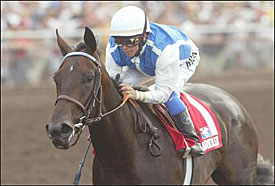 Female athletes have always been a topic of argument within the industry of sports; especially horse racing. Racing horses is strenuous for males, so what physical affect does it have on females? That is a question that is still being answered today. Certain females have proven that they can and will compete on the same level as their fellow male jockeys. So ask yourself, when do you think the sexist wall in racing began to crack down? Let's go back to the late 1980's. Prominent jockeys of that time were Bill Shoemaker, Eddie Arcaro, Johnny Longden, John Sellers, Steve Cauthen, and last but not least, Julie Krone. She was one of the most recognizable jockeys of her time. Female athletes have always been a topic of argument within the industry of sports; especially horse racing. Racing horses is strenuous for males, so what physical affect does it have on females? That is a question that is still being answered today. Certain females have proven that they can and will compete on the same level as their fellow male jockeys. So ask yourself, when do you think the sexist wall in racing began to crack down? Let's go back to the late 1980's. Prominent jockeys of that time were Bill Shoemaker, Eddie Arcaro, Johnny Longden, John Sellers, Steve Cauthen, and last but not least, Julie Krone. She was one of the most recognizable jockeys of her time.
In May 1989 Krone was featured on the cover of Sports Illustrated, which was a sight to see for the racing world! At every turn there was another client that wouldn't ride her because of her gender. The young and vibrant woman did not let that stop her, but only let it feed her desire for greatness. After her historic win in the Belmont Stakes (1993-Colonial Affair), there were likely very few trainers and owners that would deny her a mount.
Julieann "Julie" Louise Krone was born on July 24, 1963 in Benton Harbor, Michigan. She began her apprenticeship in 1981 with 747 mounts; 124 of them were awarded with winning photos. Her first year of riding she finished with 350 in the money finishes and earnings of $796,773. Her riding style continued to improve and cause more of a competitive threat through-out the following decade. She became the only woman to win riding titles at Belmont Park, Gulfstream Park, Monmouth Park, Meadowlands and Atlantic City Race Course. She was victorious in several major races before she made history. She not only rode to win, but she rode for the millions of females trying to make their own place at the track. Thought to have reached her potential, Krone kept overcoming barriers. She took her time and mended plenty of injuries on her journey to create the unbelievable racing career she is remembered for.
When the Belmont Stakes of 1993 came around, it was time for Krone's name to go down in history. Colonial Affair and his small-framed female jockey came together in winning fashion to capture the last leg of the Triple Crown. She became the first female rider to win a Triple Crown race, and to this day is the only female jockey to do so. Her first retirement came on April 18, 1999 and she ended the day with 3 winners. Krone soon started broadcasting for TVG Network, then worked in the paddock at Hollywood Park. Santa Anita Park was the track Krone picked to begin her climb out of retirement on in November of 2002. She was just getting back into racing when she suffered two fractured bones i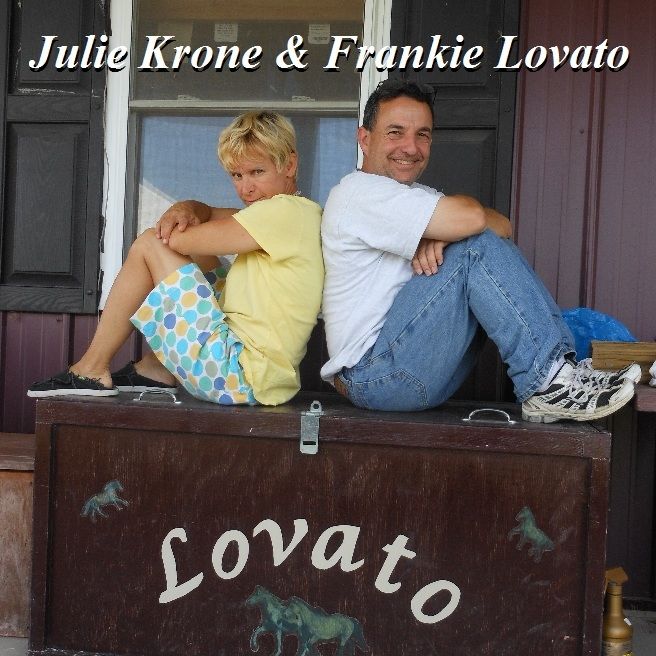 n her lower back. n her lower back.
After recovering, Krone made her comeback at Del Mar, where she rode for the remainder of the 2003 racing meet. She finished there in the lead for purse earnings. She then traveled back to Santa Anita to once again make history before hanging up her tack a second time. Krone took the reins of HalfbridledHalf Queen) in 2003 to win the Breeders' Cup Juvenile Fillies. Just weeks after her Breeders' Cup win, she was involved in a spill at Hollywood Park which left her with several broken ribs and severe muscle tears. She attempted to make another return to riding in 2004 but sadly was not able to get back to her winning form.
Krone continues to participate in legends races for the media and for the thrill of the ride. She is one of many retired jockeys that is still very much involved in the industry. Just earlier this year, she assisted Frankie Lovato with his annual Jockey Camp in Ohio. Julie Krone's voice is heard in racing on a regular basis and it seems as if it will stay that way.
.jpg)
Jockey World Member Michaela Heair is a high school student and ambitious individual. In her own words, "I have dreams and goals to achieve in life. I will work to the bone to have a successful racing career. I don't expect anything to be handed to me, I WANT to work to earn the things I desire. These things are: to be the best jockey of my ability, have a happy life doing what I love, and make history in racing."
|
|
|
|
|
|
|
|
|
|
|
"Perry Ouzts"
October 8th, 2012 by Michaela Heair
 Only 16 other jockeys in the history of North American racing have reached the level that Perry Ouzts did just 12 days ago. The 58-year-old jockey rode to his 6,000th victory aboard Tanner Me Boy at Turfway Park, September 29, 2012. Aside from that historical feat, it is great to watch Ouzts countine bringing his game to the track. It makes you wonder just what kind of legend we are watching unfold before our eyes. Only 16 other jockeys in the history of North American racing have reached the level that Perry Ouzts did just 12 days ago. The 58-year-old jockey rode to his 6,000th victory aboard Tanner Me Boy at Turfway Park, September 29, 2012. Aside from that historical feat, it is great to watch Ouzts countine bringing his game to the track. It makes you wonder just what kind of legend we are watching unfold before our eyes.
Perry Wayne Ouzts was born in Lepanto, Arkansas on July 7, 1954. He spent most of his childhood in Rivervale, Arkansas. He began getting in the saddle with his two cousins, Jackie and Earlie Fires. Ouzts made his start as a professional jockey at Beulah Park for the spring meet of 1973. He won his first career victory that same year while riding Rablu at Beulah Park.
Ouzts has his fair share of records and titles in the world of horse racing. He won 18 meet titles for River Downs, along with 11 meet titles for his home track, Beulah Park. At the time of his 5,000th win, Ouzts had raced in 39,429 races with total earnings of over $29 million. How many jockeys do you know that can say that? On August 21, 2007 Ouzts had a mount on Kandinsky at River Downs; this horse gave him his 5,000th career win. The next month, he won the $200,000 Miller Lite Cradle Stakes for two-year olds, holding the reins of Old Man Buck.
One of the most remarkable facts about this jockey's career causes you to question how he is still physically capable of riding races? Ouzts has had many potential career ending injuries and has broken or fractured several bones. To this day, if he has an injury, he recuperates and makes his comeback. January 2006 brought him one of his worst spills. Finders Chance, Ouzts' mount that day, suddenly halted atTurfway Park's quarter-pole. When this happened, the rider was thrown and then clipped by an oncoming horse on his arm. He suffered 4 cracked and 1 crushed vertebrae. He withstood 3 surgeries and was on the sideline for 11 months. Throughout that time, he never lost his winning heart, and came back to run 2nd in his returning debut.
.jpg)
Jockey World Member Michaela Heair is a high school student and ambitious individual. In her own words, "I have dreams and goals to achieve in life. I will work to the bone to have a successful racing career. I don't expect anything to be handed to me, I WANT to work to earn the things I desire. These things are: to be the best jockey of my ability, have a happy life doing what I love, and make history in racing."
|
|
|
|
|
|
|
|
|
|
|
"Martin Garcia"
September 7th, 2012 by Michaela Heair
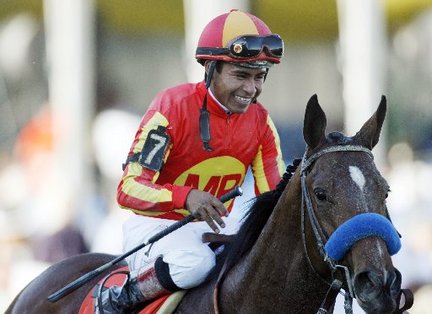 We often hear of jockeys that have won the Kentucky Derby 3 times, so on, and so forth. What about the achievements they have worked for before they have the glorious experience of racing under the Spires? Jockeys strive for success and grasp another milestone every single day. Can you tell me one of the most desired milestones? You guessed it, the 1,000th win mark. Martin Garcia's face brightened up as he rode aboard Bubba Fizz to reach his 1,000th victory by a head. This memorable day for Garcia happened August 30, 2012 at Del Mar. Mike Mitchell, trainer of Bubba Fizz, gave his rider the leg up for the 2nd race. Before Garcia was able to experience this success, he had to begin somewhere. We often hear of jockeys that have won the Kentucky Derby 3 times, so on, and so forth. What about the achievements they have worked for before they have the glorious experience of racing under the Spires? Jockeys strive for success and grasp another milestone every single day. Can you tell me one of the most desired milestones? You guessed it, the 1,000th win mark. Martin Garcia's face brightened up as he rode aboard Bubba Fizz to reach his 1,000th victory by a head. This memorable day for Garcia happened August 30, 2012 at Del Mar. Mike Mitchell, trainer of Bubba Fizz, gave his rider the leg up for the 2nd race. Before Garcia was able to experience this success, he had to begin somewhere.
Martin Garcia was born in Veracruz, Mexico on October 23, 1984. When 2003 came around he packed his bags and headed for the United States. He didn't hit the track right away; instead, he was employed at a delicatessen in Pleasanton, California. He soon came across a very important connection in racing, Mark Hanna. Garcia was fortunate, for Hanna helped him get a start in exercise riding. Not even a year later, Garcia was riding races at Golden Gate Fields. His first win came at Bay Meadows Fair. On August 17, 2005, he and Daydreamer put their game faces on for the3rd race... and won!
Now that he had his 1st win under his belt, people were waiting to see what else Garcia was going to bring. He did not keep them waiting long at all. In 2006, he beat Russel Baze for leading jockey at Golden Gate Fields. Also, he tied with Baze by a victory for a title at Bay Meadows. After his triumph at Golden Gate, Garcia moved his tack to Hollywood Park. At that meet, he finished 3rd in the standings with 46 winning rides. The year 2010 started the string of Baffert/Garcia winners. Bob Baffert allowed Garcia to take the reins of Lookin at Lucky in the 2010 Preakness Stakes.Baffert realized when he met his horse in the winners circle it was not by any means a mistake. Almost 3 months later, the winning pair returned in the Haskell Invitational. Lookin at Lucky and Garcia had their picture taken again. Garcia and Baffert met up for more G1 races.
May 6, 2011 was a day Garcia would never forget. He crossed the wire for a Kentucky Oaks win with Plum Pretty's muscles roaring under him. The next day, he rode another Baffert horse, C J Russell, to win the Twinspires.com race under the Spires. He later went on to win consecutive Haskell Invitational's. This time it was with one of Baffert's top colts, Coil. 2011 called for more G1 wins for the jockey. He won the Hollywood Gold Cup with First Dude and was up for Drill's victory in the Del Mar Futurity. Last but not least, he rode The Factor to first in the Malibu, then in the Pat O'Brien. Baffert has continued give Garcia a leg up this year, including for a victory in the Las Virgenes with Eden's Moon.
.jpg)
Jockey World Member Michaela Heair is a high school student and ambitious individual. In her own words, "I have dreams and goals to achieve in life. I will work to the bone to have a successful racing career. I don't expect anything to be handed to me, I WANT to work to earn the things I desire. These things are: to be the best jockey of my ability, have a happy life doing what I love, and make history in racing."
|
|
|
|
|
|
|
|
|
|
|
"Irad Ortiz, Jr."
August 7th, 2012 by Michaela Heair
 Originally from Trujillo Alto in Puerto Rico, Irad Ortiz, Jr. graduated from Escuela Vocacional Hípica, a school that helps produce Thoroughbred jockeys. He followed in the footsteps of his grandfather, Irad Ortiz, and uncle, Ivan Ortiz. New Year's Day of 2011 the young apprentice jockey began his career at Hipodromo Camarero. Originally from Trujillo Alto in Puerto Rico, Irad Ortiz, Jr. graduated from Escuela Vocacional Hípica, a school that helps produce Thoroughbred jockeys. He followed in the footsteps of his grandfather, Irad Ortiz, and uncle, Ivan Ortiz. New Year's Day of 2011 the young apprentice jockey began his career at Hipodromo Camarero.
Ortiz, Jr., started off winning 76 races from 357 mounts. He was quickly noticed by a NYRA peace officer, Pito Rosa. Rosa pursued talking to jockey agent, Tony Macallef, about carrying Ortiz's book. Ortiz made the decision to move his tack to the New York circuit, which would be a decision that would soon prove well made. Following his arrival on theNYRA circuit, his talent shined through with his mounts. Each meet that passed by, his rank kept moving up on the list. He tied for 12th at Saratoga, tied for 6th at Belmont Park, and also tied for 4th at Aqueduct.
Being a jockey has it's risks, like all sports. Ortiz, Jr., was involved in a spill in May 2011. The fall resulted in the rider having a concussion. He put his feet back in the irons to rebound with a victory in the Corma Ray Stakes at Belmont Park last September. He concluded the 2011 racing year with 151 wins from 1,016 mounts and $2,861,694 in earnings. The week of January 16, 2012 he led all North American jockeys by earnings for the week. He earned $346,357 after 10 wins from 38 starts within 7 days. Just one year after beginning his riding career, he achieved a 4 win day on January 2, 2012 at Aqueduct.
Just last weekend in the Alfred G. Vanderbilt Handicap, he guided Poseidon's Warrior to a major upset win at 36-1. This victory also went down as Ortiz's second career G1 win. His first G1 win came when he piloted Quested across the wire in the G1 TVG Network Coaching Club American Oaks.
He is just a few days shy of his 20th birthday, which will be celebrated on August 11, 2012. Wednesday August 8 he will be getting a leg up in 2 stakes races. Ortiz has the mount on King Kreesa for Jeremiah Englehart in the New York Stallion Series Stakes; This race will be run over the inner turf as the5th race at Saratoga. Leah Gyarmati is handing over the reins of Well Kept to Ortiz in the Mandy's Gold Stakes. The pair will load into the one hole for the 8th race on the card in the 6 1/2 furlong dirt race also at Saratoga.
.jpg)
Jockey World Member Michaela Heair is a high school student and ambitious individual. In her own words, "I have dreams and goals to achieve in life. I will work to the bone to have a successful racing career. I don't expect anything to be handed to me, I WANT to work to earn the things I desire. These things are: to be the best jockey of my ability, have a happy life doing what I love, and make history in racing."
|
|
|
|
|
|
|
|
|
|
|
"Rafael Bejarano"
July 6th, 2012 by Michaela Heair
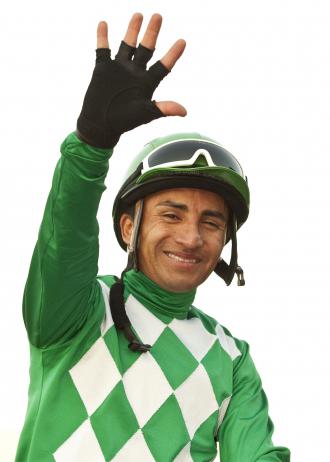 On June 23, 1982, Rafael Bejarano was brought into this world destined for greatness. The jockey that anyone in modern racing knows began his journey in our sport in 1999. Before he embarked on his professional career he trained at the Peruvian national riding school. He soon knew the feeling of success after he won the apprentice riding title at Hipodromo de Monterrico in Lima. On June 23, 1982, Rafael Bejarano was brought into this world destined for greatness. The jockey that anyone in modern racing knows began his journey in our sport in 1999. Before he embarked on his professional career he trained at the Peruvian national riding school. He soon knew the feeling of success after he won the apprentice riding title at Hipodromo de Monterrico in Lima.
Louisville, Kentucky was calling his name in the spring of 2002. July 10th brought him his first win at River Downs; he went on to pursue mounts in more major races locally. In 2004, Bejarano was the United States Champion jockey by wins having victories in 455 races. In 2004 his earnings were $12,212,308 from 1,922 mounts. Andromeda’s Hero gave him an8th place finish in the 2005 Kentucky Derby. His best Preakness result was aboard Sun King in 2005 finishing 4ths Hero in the Belmont and pulled away by about 7 lengths behind the winner Afleet Alex. In 2007 Bejarano and 8-1 longshot, Dominican, defeated eventual Kentucky Derby winner, Street Sense, in a dramatic Bluegrass Stakes photo finish.
He’s put a few Breeders’ Cup wins under his belt, with his first coming in the F&M Turf with Intercontinental in the 2005 edition. Two years later he won another Breeder’s Cup win for Robert Frankel in the Ladies’ Classic aboard Ginger Punch. Last year he took the inaugural running of the Juvenile Sprint with Secret Circle for Bob Baffert. On July 4th he had an entry on another Baffert colt, Liaison, in the Swaps Stakes at Betfair Hollywood Park.
.jpg)
Jockey World Member Michaela Heair is a high school student and ambitious individual. In her own words, "I have dreams and goals to achieve in life. I will work to the bone to have a successful racing career. I don't expect anything to be handed to me, I WANT to work to earn the things I desire. These things are: to be the best jockey of my ability, have a happy life doing what I love, and make history in racing."
|
|
|
|
|
|
|
|
|
|
|
"Victor Espinoza"
June 27, 2012 by Michaela Heair
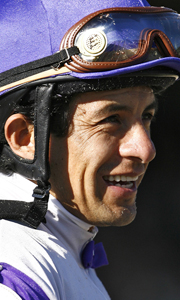 Victor Espinoza was born May 23, 1972 in Mexico City, Mexico. Before Victor decided to take up to riding, he was originally driving a bus in his native. His riding began at a farm outside of Mexico City, it didn’t take him long to attend a jockey school after getting a taste. He attended the jockey school for 1 year, and went on to win his first race at Hippodromo de las Americas in 1992. Four months later he moved his tack to the United States. In the United States in 1993, he rode at Santa Anita Park, then Bay Meadows. Victor Espinoza was born May 23, 1972 in Mexico City, Mexico. Before Victor decided to take up to riding, he was originally driving a bus in his native. His riding began at a farm outside of Mexico City, it didn’t take him long to attend a jockey school after getting a taste. He attended the jockey school for 1 year, and went on to win his first race at Hippodromo de las Americas in 1992. Four months later he moved his tack to the United States. In the United States in 1993, he rode at Santa Anita Park, then Bay Meadows.
Espinoza was leading apprentice at Bay Meadows in 1993-94 and at Golden Gate in 1994. In 1996-97 Fairplex became another site of success for the jockey; he topped their standings in the consecutive years. His breakthrough year was 2000; he won 3 riding titles and 31 stakes races, 15 of them being graded. He made his Triple Crown bid aboard War Emblem in 2002 after he won the Kentucky Derby and Preakness Stakes. The pair failed to win the Belmont Stakes after a stumbling start at the gates.
In 2007 he was the regular rider of The Tin Man, winner of theG1 Shoemaker BC Mile. 2011 was another fantastic year; he won the Santa Anita Derby (G1) with Midnight Interlude, the Sunshine Millions Distaff with Evening Jewel, and the Del Mar Handicap (G2) with Celtic New Year. Espinoza has 1 Breeders’ Cup win under his belt, after he won the 2000 Distaff with Spain.
.jpg)
Jockey World Member Michaela Heair is a high school student and ambitious individual. In her own words, "I have dreams and goals to achieve in life. I will work to the bone to have a successful racing career. I don't expect anything to be handed to me, I WANT to work to earn the things I desire. These things are: to be the best jockey of my ability, have a happy life doing what I love, and make history in racing."
|
|
|
|
|
|
|
|
|
|
|
"Jose Lezcano"
June 21, 2012 by Michaela Heair
 Jose Lezcano was born April 20, 1985 in Panama. His journeys of becoming a jockey began under the guidance of Laffit Pincay while he attended his jockey school. When January of 2003 came around, Jose made the move to the U.S. to launch his career at Gulfstream Park. Cloudy Gray gave him his first win in March 2004. Jose Lezcano was born April 20, 1985 in Panama. His journeys of becoming a jockey began under the guidance of Laffit Pincay while he attended his jockey school. When January of 2003 came around, Jose made the move to the U.S. to launch his career at Gulfstream Park. Cloudy Gray gave him his first win in March 2004.
One year later he spent a full season at Monmouth finishing 5th in the overall standings, people soon began to give him more mounts. In 2008 Lezcano had 1 mount on the Breeders’ Cup card, but one was all he needed to win.
Maram carried Jose Lezcano in a victory in the inaugural edition of the Breeders’ Cup Juvenile Fillies Turf. 2008 continued to bring him success as he was the leading rider at Monmouth with 141 wins. He went on to take the fall season at Meadowlands Racetrack. Lezcano moved back down south to where he began in the U.S, he earned the leading rider title at Gulfstream Park.
His best Kentucky Derby finish has been aboard Ice Box where he finished 2nd in 2010. Lezcano has won 2 consecutive Black-Eyed Susan Stakes, in 2010 aboard Acting Happy, and then he returned to Pimlico and won with Royal Delta the next year. He kept his mount on Royal Delta and notched another Breeders’ Cup in the Ladies’ Classic by 2 ½ lengths under the Twin Spires. He’s looking for more stakes wins this year after winning the Florida Oaks with Dixie Strike and the Stephen Foster Handicap in the saddle of Ron The Greek.
.jpg)
Jockey World Member Michaela Heair is a high school student and ambitious individual. In her own words, "I have dreams and goals to achieve in life. I will work to the bone to have a successful racing career. I don't expect anything to be handed to me, I WANT to work to earn the things I desire. These things are: to be the best jockey of my ability, have a happy life doing what I love, and make history in racing."
|
|
|
|
|
|
|
|
|
|
|
"Robby Albarado"
June 12, 2012 by Michaela Heair
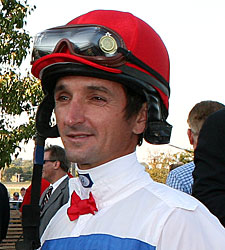 Robby Albarado, one of the most recognized jockeys of this time, was born September 11, 1973. He lived his younger years in Louisiana, which is also where he began riding at bush tracks at the age of 12. He soon turned professional; earning his first win at Evangeline Downs in 1990. Like jockeys and any professional athlete, he has had career setbacks due to injuries, but every time he came back on the top of his game. During 1998 and 1999 he suffered 2 skull injuries. Another fall of 2000 kept him out of racing for the most part of 2001. Robby Albarado, one of the most recognized jockeys of this time, was born September 11, 1973. He lived his younger years in Louisiana, which is also where he began riding at bush tracks at the age of 12. He soon turned professional; earning his first win at Evangeline Downs in 1990. Like jockeys and any professional athlete, he has had career setbacks due to injuries, but every time he came back on the top of his game. During 1998 and 1999 he suffered 2 skull injuries. Another fall of 2000 kept him out of racing for the most part of 2001.
His big break came not long after his return when he rode to victory in the Jockey Club Gold Cup aboard Horse of the Year, Mineshaft. Robby Albarado was voted the 2004 George Woolf Memorial Jockey Award. As the regular jockey for the known Curlin, Albarado rode him to a 3rd place finish in the 2007 Kentucky Derby. The pair synced in the Preakness Stakes 2 weeks later, and made their way to the winner’s circle at Pimlico. They couldn’t get the feeling of winning the Belmont Stakes when Rags To Riches took the victory by a nose. After the low of losing the Belmont, Curlin gave his jockey his first Breeders’ Cup Classic win.
On May 30, 2009 he recorded his 4,000th win on the back of Keertana in the 9th race at Churchill Downs. Robby Albarado is putting more wins under his belt and is making his bid for who knows, the Hall of Fame one day?
.jpg)
Jockey World Member Michaela Heair is a high school student and ambitious individual. In her own words, "I have dreams and goals to achieve in life. I will work to the bone to have a successful racing career. I don't expect anything to be handed to me, I WANT to work to earn the things I desire. These things are: to be the best jockey of my ability, have a happy life doing what I love, and make history in racing."
|
|
|
|
|
|
|
|
|
|
|
"Kristina McManigell"
June 5, 2012 by Michaela Heair
 Kristina McManigell, a young tomboy in her childhood, was born in Mattoon, IL. She grew up an hour away from Ellis Park and had 4-H and trail riding experience. After graduating high school, she quickly moved to Lexington, KY. She was one of the new comers into Chris McCarron’s jockey school. Kristina McManigell, a young tomboy in her childhood, was born in Mattoon, IL. She grew up an hour away from Ellis Park and had 4-H and trail riding experience. After graduating high school, she quickly moved to Lexington, KY. She was one of the new comers into Chris McCarron’s jockey school.
Kristina was successful in his program, like a few jockey graduates that have walked through his doors. She took out her jockey license one year after graduating North American Racing Academy; she had been galloping for Todd Pletcher. The new jockey experienced her first race in the saddle at Churchill Downs going 1m 1/16 on the dirt. Although she finished last, she still smiles on the memory of that first mount.
There is also the memory of her first win that is one of the days a jockey dreams about. On January 7, 2010 at Tampa Bay Downs it would become reality. She won the 2nd race aboard Real Stormy by a nose. She has accomplished several goals on her list, but there are some that haven’t been crossed out just yet! Kristina wants to win the Eclipse Award for apprentice, along with as many races as possible. She shines with passion for this sport and shows it through her work, dedication, and winning photos. She has had her fair share of tough moments in the industry, but is making the best of it and is gradually moving up in the racing world.
.jpg)
Jockey World Member Michaela Heair is a high school student and ambitious individual. In her own words, "I have dreams and goals to achieve in life. I will work to the bone to have a successful racing career. I don't expect anything to be handed to me, I WANT to work to earn the things I desire. These things are: to be the best jockey of my ability, have a happy life doing what I love, and make history in racing."
|
|
|
|
|
|
|
|
|
|
|
"Javier Castellano"
May 29, 2012 by Michaela Heair
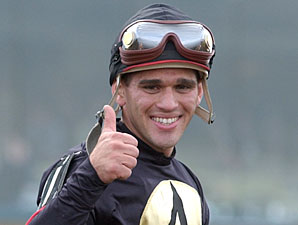 On October 23, 1977 Javier Castellano was born straight into a racing family. His uncle was a jockey, as for his brother. Castellano calls his father, a former jockey, the greatest influence on his career. He had his first mounts in Venezuela in 1996. Soon afterwards, he moved to the United States. He began riding on the South Florida circuit, and that continues to be one of the main circuits he rides. First winner in the United States was Phone Man on July 31, 1997, at Calder. Castellano decided to move to New York in 2001 and finished 6th in standings. In 2002 he finished only 2nd, as every year he worked his way up in the standings and critics’ eyes. On October 23, 1977 Javier Castellano was born straight into a racing family. His uncle was a jockey, as for his brother. Castellano calls his father, a former jockey, the greatest influence on his career. He had his first mounts in Venezuela in 1996. Soon afterwards, he moved to the United States. He began riding on the South Florida circuit, and that continues to be one of the main circuits he rides. First winner in the United States was Phone Man on July 31, 1997, at Calder. Castellano decided to move to New York in 2001 and finished 6th in standings. In 2002 he finished only 2nd, as every year he worked his way up in the standings and critics’ eyes.
This top jockey earned his 1st Triple Crown race victory with Bernardini in 2006 at Pimlico in the prestigious Preakness Stakes. Castellano rode Bernardini right to being named champion 3-year-old of 2006. He has won five consecutive races at Saratoga in 2010, believed to be the first to achieve that feat.
He’s had his fair share of Breeders’ Cup races, with the most important win aboard Ghostzapper in the 2004 Breeders’ Cup Classic. He finished 2nd in the saddle of Bernardini under the Twin Spires coming across the wire in the Classic. Recently he has been riding to multiple graded stakes victories and sits at #1 in graded earnings. Castellano is still in the peak of his career and produces wins as every day he is still learning skills to make him a better jockey.
.jpg)
Jockey World Member Michaela Heair is a high school student and ambitious individual. In her own words, "I have dreams and goals to achieve in life. I will work to the bone to have a successful racing career. I don't expect anything to be handed to me, I WANT to work to earn the things I desire. These things are: to be the best jockey of my ability, have a happy life doing what I love, and make history in racing."
|
|
|
|
|
|
|
|
|
|
|
"Joe Talamo"
May 22, 2012 by Michaela Heair
 Joe Talamo was born on January 12, 1990; he lived the younger years of his life in the New Orleans metropolitan area. He was introduced to racing as a toddler by his father, who was an assistant trainer. At the age 11 he took his first step to getting in the equine industry. He began riding and doing chores at a nearby stable. Like many successful Cajun jockeys, Talamo first raced at a bush track. Joe Talamo was born on January 12, 1990; he lived the younger years of his life in the New Orleans metropolitan area. He was introduced to racing as a toddler by his father, who was an assistant trainer. At the age 11 he took his first step to getting in the equine industry. He began riding and doing chores at a nearby stable. Like many successful Cajun jockeys, Talamo first raced at a bush track.
As each day passed his desire for the track grew, he made the decision to leave high school and pursue his career as a jockey. He officially debuted at Louisiana Downs in June 2006. Not long after, he became the first apprentice jockey to achieve a title at Fair Grounds in his home territory. 2007 proved to be his break out year when he moved to the California circuit. That year he earned the number 5 G1 stakes victories and was voted Eclipse Award United States Champion Apprentice Jockey.
Talamo was the regular jockey on 2009 Kentucky Derby favorite I Want Revenge, but they didn't get to the starting gate when the horse was scratched the day of the race. The following year he made his way back to Churchill Downs with hope of redeeming the Kentucky Derby with Sidney's Candy. The pair finished 17th and out of the money. He became even more recognized when he was featured in Animal Planet's, Jockey. He is still currently making success on the California circuit, and is proving there are still many great things to come from his riding.
.jpg)
Jockey World Member Michaela Heair is a high school student and ambitious individual. In her own words, "I have dreams and goals to achieve in life. I will work to the bone to have a successful racing career. I don't expect anything to be handed to me, I WANT to work to earn the things I desire. These things are: to be the best jockey of my ability, have a happy life doing what I love, and make history in racing."
|
|
|
|
|
|
|
|
|
|
|
"Rosie Napravnik"
May 14, 2012 by Michaela Heair
 Anna Rose “Rosie” Napravnik came into this world February 9, 1988 in Morristown, New Jersey. She was brought up around the presence of horses, and grew knowing what she wanted to pursue. Napravnik took the major step of taking out her jockey license in 2005. It didn’t take her long to show what kind of rider she is. When she started she was one of the top riders in Maryland and continues to be the top female rider in the United States. Anna Rose “Rosie” Napravnik came into this world February 9, 1988 in Morristown, New Jersey. She was brought up around the presence of horses, and grew knowing what she wanted to pursue. Napravnik took the major step of taking out her jockey license in 2005. It didn’t take her long to show what kind of rider she is. When she started she was one of the top riders in Maryland and continues to be the top female rider in the United States.
In 2006, it was her breakout year; she finished with 300 victories out of 1,465 mounts with earnings of $6,395,075. That same year she was runner up for the Eclipse Award for Outstanding Apprentice Jockey. Also, she has achieved riding titles at Pimlico Racecourse and Laurel Park Racecourse at all 4 meets.
In order to get to her success as a female jockey, she has had to overcome major injuries. She suffered a broken left leg in a racing accident at Delaware Park in August 2008. After healing up and awaiting her return for the races, she came back in November 2008 on the New York circuit. She rode Pants on Fire to a 9th place finish at the 2011 Kentucky Derby, the best finish for a woman in the history of the Derby. It was with a Jones horse that she made history just this month. She rode Believe You Can to a victory in the Kentucky Oaks, making her the first female to win the race.
.jpg)
Jockey World Member Michaela Heair is a high school student and ambitious individual. In her own words, "I have dreams and goals to achieve in life. I will work to the bone to have a successful racing career. I don't expect anything to be handed to me, I WANT to work to earn the things I desire. These things are: to be the best jockey of my ability, have a happy life doing what I love, and make history in racing."
|
|
|
|
|
|
|
|
|
|
|
|
|
|
|
|
|
|
|
|
|
|
Contact: info@jockeyworld.org
.jpg)
Education, Health & Safety into
the world of Horse Racing
If you have questions or would like to learn more how you can help and support Jockey World, please email: info@jockeyworld.org
|
|
|
|
|
|
|
|
|
|
|

Join Jockey World

Like Jockey World

Follow Jockey World

Watch Jockey World
|
|
|
|
|
|
|
|
|
|
| There have been no posts in the last 10 days. |
|
|
|
|
|
|
|
|